[FREE] Fun Math Games & Activities Packs
Always on the lookout for fun math games and activities in the classroom? Try our ready-to-go printable packs for students to complete independently or with a partner!
In order to access this I need to be confident with:
Fraction word prob.

Fraction word problems
Here you will learn about fraction word problems, including solving math word problems within a real-world context involving adding fractions, subtracting fractions, multiplying fractions, and dividing fractions.
Students will first learn about fraction word problems as part of number and operations—fractions in 4 th grade.
What are fraction word problems?
Fraction word problems are math word problems involving fractions that require students to use problem-solving skills within the context of a real-world situation.
To solve a fraction word problem, you must understand the context of the word problem, what the unknown information is, and what operation is needed to solve it. Fraction word problems may require addition, subtraction, multiplication, or division of fractions.
After determining what operation is needed to solve the problem, you can apply the rules of adding, subtracting, multiplying, or dividing fractions to find the solution.
For example,
Natalie is baking 2 different batches of cookies. One batch needs \cfrac{3}{4} cup of sugar and the other batch needs \cfrac{2}{4} cup of sugar. How much sugar is needed to bake both batches of cookies?
You can follow these steps to solve the problem:
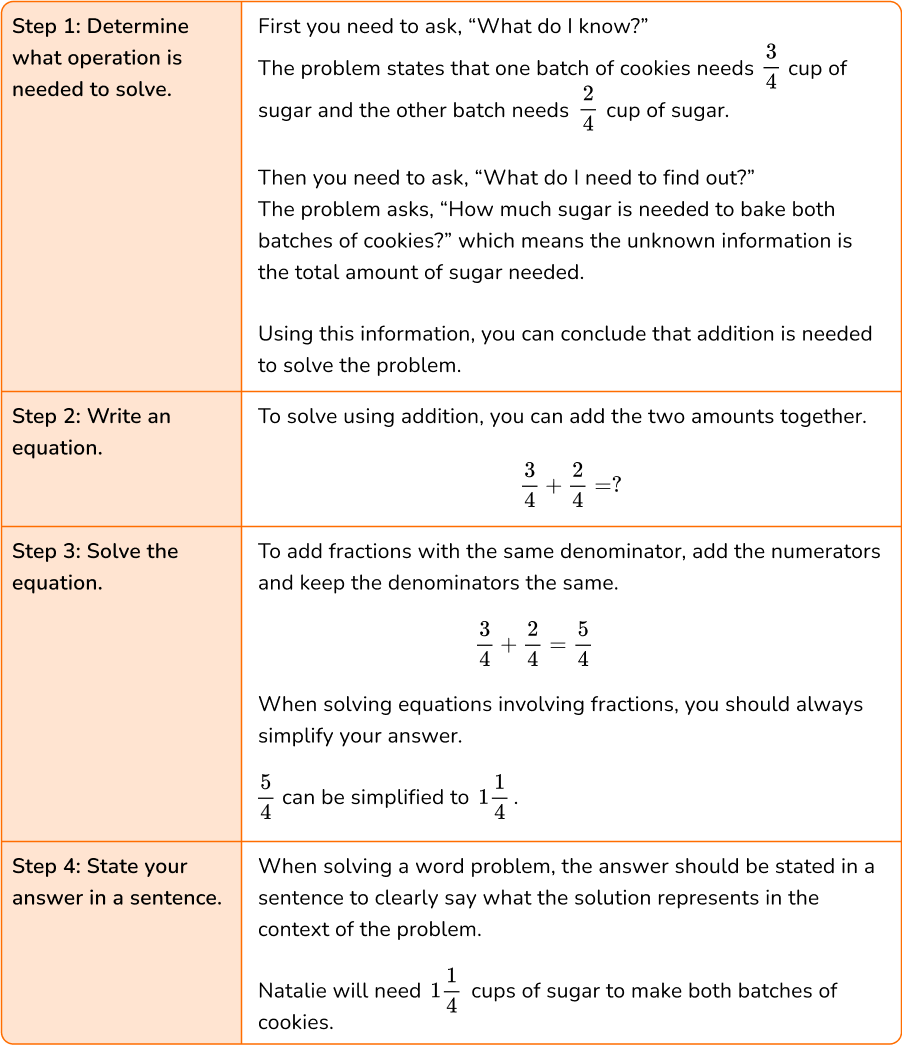
Step-by-step guide: Adding and subtracting fractions
Step-by-step guide: Adding fractions
Step-by-step guide: Subtracting fractions
Step-by-step guide: Multiplying and dividing fractions
Step-by-step guide: Multiplying fractions
Step-by-step guide: Dividing fractions
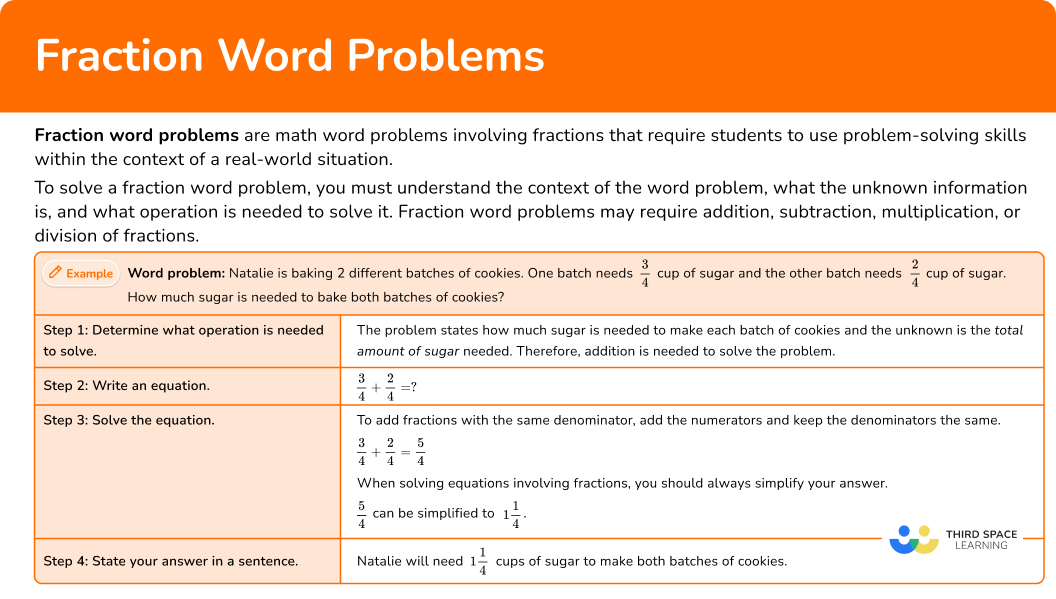
Common Core State Standards
How does this relate to 4 th grade math to 6 th grade math?
- Grade 4: Number and Operations—Fractions (4.NF.B.3d) Solve word problems involving addition and subtraction of fractions referring to the same whole and having like denominators, e.g., by using visual fraction models and equations to represent the problem.
- Grade 4: Number and Operations—Fractions (4.NF.B.4c) Solve word problems involving multiplication of a fraction by a whole number, e.g., by using visual fraction models and equations to represent the problem. For example, if each person at a party will eat \cfrac{3}{8} of a pound of roast beef, and there will be 5 people at the party, how many pounds of roast beef will be needed? Between what two whole numbers does your answer lie?
- Grade 5: Number and Operations—Fractions (5.NF.A.2) Solve word problems involving addition and subtraction of fractions referring to the same whole, including cases of unlike denominators, e.g., by using visual fraction models or equations to represent the problem. Use benchmark fractions and number sense of fractions to estimate mentally and assess the reasonableness of answers. For example, recognize an incorrect result \cfrac{2}{5}+\cfrac{1}{2}=\cfrac{3}{7} by observing that \cfrac{3}{7}<\cfrac{1}{2} .
- Grade 5: Number and Operations—Fractions (5.NF.B.6) Solve real world problems involving multiplication of fractions and mixed numbers, e.g., by using visual fraction models or equations to represent the problem.
- Grade 5: Number and Operations—Fractions (5.NF.B.7c) Solve real world problems involving division of unit fractions by non-zero whole numbers and division of whole numbers by unit fractions, e.g., by using visual fraction models and equations to represent the problem. For example, how much chocolate will each person get if 3 people share \cfrac{1}{2} \: lb of chocolate equally? How many \cfrac{1}{3} cup servings are in 2 cups of raisins?
- Grade 6: The Number System (6.NS.A.1) Interpret and compute quotients of fractions, and solve word problems involving division of fractions by fractions, e.g., by using visual fraction models and equations to represent the problem. For example, create a story context for \cfrac{2}{3} \div \cfrac{4}{5} and use a visual fraction model to show the quotient; use the relationship between multiplication and division to explain that \cfrac{2}{3} \div \cfrac{4}{5}=\cfrac{8}{9} because \cfrac{3}{4} of \cfrac{8}{9} is \cfrac{2}{3}. (In general, \cfrac{a}{b} \div \cfrac{c}{d}=\cfrac{a d}{b c} \, ) How much chocolate will each person get if 3 people share \cfrac{1}{2} \: lb of chocolate equally? How many \cfrac{3}{4} cup servings are in \cfrac{2}{3} of a cup of yogurt? How wide is a rectangular strip of land with length \cfrac{3}{4} \: m and area \cfrac{1}{2} \: m^2?
![problem solving on fractions [FREE] Fraction Operations Worksheet (Grade 4 to 6)](https://thirdspacelearning.com/wp-content/uploads/2023/07/Fraction-operations-check-for-understandin-quiz-listing-image-.png)
[FREE] Fraction Operations Worksheet (Grade 4 to 6)
Use this quiz to check your grade 4 to 6 students’ understanding of fraction operations. 10+ questions with answers covering a range of 4th to 6th grade fraction operations topics to identify areas of strength and support!
How to solve fraction word problems
In order to solve fraction word problems:
Determine what operation is needed to solve.
Write an equation.
Solve the equation.
State your answer in a sentence.
Fraction word problem examples
Example 1: adding fractions (like denominators).
Julia ate \cfrac{3}{8} of a pizza and her brother ate \cfrac{2}{8} of the same pizza. How much of the pizza did they eat altogether?
The problem states how much pizza Julia ate and how much her brother ate. You need to find how much pizza Julia and her brother ate altogether , which means you need to add.
2 Write an equation.
3 Solve the equation.
To add fractions with like denominators, add the numerators and keep the denominators the same.
4 State your answer in a sentence.
The last step is to go back to the word problem and write a sentence to clearly say what the solution represents in the context of the problem.
Julia and her brother ate \cfrac{5}{8} of the pizza altogether.
Example 2: adding fractions (unlike denominators)
Tim ran \cfrac{5}{6} of a mile in the morning and \cfrac{1}{3} of a mile in the afternoon. How far did Tim run in total?
The problem states how far Tim ran in the morning and how far he ran in the afternoon. You need to find how far Tim ran in total , which means you need to add.
To add fractions with unlike denominators, first find a common denominator and then change the fractions accordingly before adding.
\cfrac{5}{6}+\cfrac{1}{3}= \, ?
The least common multiple of 6 and 3 is 6, so 6 can be the common denominator.
That means \cfrac{1}{3} will need to be changed so that its denominator is 6. To do this, multiply the numerator and the denominator by 2.
\cfrac{1 \times 2}{3 \times 2}=\cfrac{2}{6}
Now you can add the fractions and simplify the answer.
\cfrac{5}{6}+\cfrac{2}{6}=\cfrac{7}{6}=1 \cfrac{1}{6}
Tim ran a total of 1 \cfrac{1}{6} miles.
Example 3: subtracting fractions (like denominators)
Pia walked \cfrac{4}{7} of a mile to the park and \cfrac{3}{7} of a mile back home. How much farther did she walk to the park than back home?
The problem states how far Pia walked to the park and how far she walked home. Since you need to find the difference ( how much farther ) between the two distances, you need to subtract.
To subtract fractions with like denominators, subtract the numerators and keep the denominators the same.
\cfrac{4}{7}-\cfrac{3}{7}=\cfrac{1}{7}
Pia walked \cfrac{1}{7} of a mile farther to the park than back home.
Example 4: subtracting fractions (unlike denominators)
Henry bought \cfrac{7}{8} pound of beef from the grocery store. He used \cfrac{1}{3} of a pound of beef to make a hamburger. How much of the beef does he have left?
The problem states how much beef Henry started with and how much he used. Since you need to find how much he has left , you need to subtract.
To subtract fractions with unlike denominators, first find a common denominator and then change the fractions accordingly before subtracting.
\cfrac{7}{8}-\cfrac{1}{3}= \, ?
The least common multiple of 8 and 3 is 24, so 24 can be the common denominator.
That means both fractions will need to be changed so that their denominator is 24.
To do this, multiply the numerator and the denominator of each fraction by the same number so that it results in a denominator of 24. This will give you an equivalent fraction for each fraction in the problem.
\begin{aligned}&\cfrac{7 \times 3}{8 \times 3}=\cfrac{21}{24} \\\\ &\cfrac{1 \times 8}{3 \times 8}=\cfrac{8}{24} \end{aligned}
Now you can subtract the fractions.
\cfrac{21}{24}-\cfrac{8}{24}=\cfrac{13}{24}
Henry has \cfrac{13}{24} of a pound of beef left.
Example 5: multiplying fractions
Andre has \cfrac{3}{4} of a candy bar left. He gives \cfrac{1}{2} of the remaining bit of the candy bar to his sister. What fraction of the whole candy bar does Andre have left now?
It could be challenging to determine the operation needed for this problem; many students may automatically assume it is subtraction since you need to find how much of the candy bar is left.
However, since you know Andre started with a fraction of the candy bar and you need to find a fraction OF a fraction, you need to multiply.
The difference here is that Andre did NOT give his sister \cfrac{1}{2} of the candy bar, but he gave her \cfrac{1}{2} of \cfrac{3}{4} of a candy bar.
To solve the word problem, you can ask, “What is \cfrac{1}{2} of \cfrac{3}{4}? ” and set up the equation accordingly. Think of the multiplication sign as meaning “of.”
\cfrac{1}{2} \times \cfrac{3}{4}= \, ?
To multiply fractions, multiply the numerators and multiply the denominators.
\cfrac{1}{2} \times \cfrac{3}{4}=\cfrac{3}{8}
Andre gave \cfrac{1}{2} of \cfrac{3}{4} of a candy bar to his sister, which means he has \cfrac{1}{2} of \cfrac{3}{4} left. Therefore, Andre has \cfrac{3}{8} of the whole candy bar left.
Example 6: dividing fractions
Nia has \cfrac{7}{8} cup of trail mix. How many \cfrac{1}{4} cup servings can she make?
The problem states the total amount of trail mix Nia has and asks how many servings can be made from it.
To solve, you need to divide the total amount of trail mix (which is \cfrac{7}{8} cup) by the amount in each serving ( \cfrac{1}{4} cup) to find out how many servings she can make.
To divide fractions, multiply the dividend by the reciprocal of the divisor.
\begin{aligned}& \cfrac{7}{8} \div \cfrac{1}{4}= \, ? \\\\ & \downarrow \downarrow \downarrow \\\\ &\cfrac{7}{8} \times \cfrac{4}{1}=\cfrac{28}{8} \end{aligned}
You can simplify \cfrac{28}{8} to \cfrac{7}{2} and then 3 \cfrac{1}{2}.
Nia can make 3 \cfrac{1}{2} cup servings.
Teaching tips for fraction word problems
- Encourage students to look for key words to help determine the operation needed to solve the problem. For example, subtracting fractions word problems might ask students to find “how much is left” or “how much more” one fraction is than another.
- Provide students with an answer key to word problem worksheets to allow them to obtain immediate feedback on their solutions. Encourage students to attempt the problems independently first, then check their answers against the key to identify any mistakes and learn from them. This helps reinforce problem-solving skills and confidence.
- Be sure to incorporate real-world situations into your math lessons. Doing so allows students to better understand the relevance of fractions in everyday life.
- As students progress and build a strong foundational understanding of one-step fraction word problems, provide them with multi-step word problems that involve more than one operation to solve.
- Take note that students will not divide a fraction by a fraction as shown above until 6 th grade (middle school), but they will divide a unit fraction by a whole number and a whole number by a fraction in 5 th grade (elementary school), where the same mathematical rules apply to solving.
- There are many alternatives you can use in place of printable math worksheets to make practicing fraction word problems more engaging. Some examples are online math games and digital workbooks.
Easy mistakes to make
- Misinterpreting the problem Misreading or misunderstanding the word problem can lead to solving for the wrong quantity or using the wrong operation.
- Not finding common denominators When adding or subtracting fractions with unlike denominators, students may forget to find a common denominator, leading to an incorrect answer.
- Forgetting to simplify Unless a problem specifically says not to simplify, fractional answers should always be written in simplest form.
Related fractions operations lessons
- Fractions operations
- Multiplicative inverse
- Reciprocal math
- Fractions as divisions
Practice fraction word problem questions
1. Malia spent \cfrac{5}{6} of an hour studying for a math test. Then she spent \cfrac{1}{3} of an hour reading. How much longer did she spend studying for her math test than reading?
Malia spent \cfrac{1}{2} of an hour longer studying for her math test than reading.

Malia spent \cfrac{5}{18} of an hour longer studying for her math test than reading.

Malia spent \cfrac{1}{2} of an hour longer reading than studying for her math test.
Malia spent 1 \cfrac{1}{6} of an hour longer studying for her math test than reading.
To find the difference between the amount of time Malia spent studying for her math test than reading, you need to subtract. Since the fractions have unlike denominators, you need to find a common denominator first.
You can use 6 as the common denominator, so \cfrac{1}{3} becomes \cfrac{3}{6}. Then you can subtract.
\cfrac{3}{6} can then be simplified to \cfrac{1}{2}.
Finally, you need to choose the answer that correctly answers the question within the context of the situation. Therefore, the correct answer is “Malia spent \cfrac{1}{2} of an hour longer studying for her math test than reading.”
2. A square garden is \cfrac{3}{4} of a meter wide and \cfrac{8}{9} of a meter long. What is its area?
The area of the garden is 1\cfrac{23}{36} square meters.
The area of the garden is \cfrac{27}{32} square meters.
The area of the garden is \cfrac{2}{3} square meters.
The perimeter of the garden is \cfrac{2}{3} meters.
To find the area of a square, you multiply the length and width. So to solve, you multiply the fractional lengths by mulitplying the numerators and multiplying the denominators.
\cfrac{24}{36} can be simplified to \cfrac{2}{3}.
Therefore, the correct answer is “The area of the garden is \cfrac{2}{3} square meters.”
3. Zoe ate \cfrac{3}{8} of a small cake. Liam ate \cfrac{1}{8} of the same cake. How much more of the cake did Zoe eat than Liam?
Zoe ate \cfrac{3}{64} more of the cake than Liam.
Zoe ate \cfrac{1}{4} more of the cake than Liam.
Zoe ate \cfrac{1}{8} more of the cake than Liam.
Liam ate \cfrac{1}{4} more of the cake than Zoe.
To find how much more cake Zoe ate than Liam, you subtract. Since the fractions have the same denominator, you subtract the numerators and keep the denominator the same.
\cfrac{2}{8} can be simplified to \cfrac{1}{4}.
Therefore, the correct answer is “Zoe ate \cfrac{1}{4} more of the cake than Liam.”
4. Lila poured \cfrac{11}{12} cup of pineapple and \cfrac{2}{3} cup of mango juice in a bottle. How many cups of juice did she pour into the bottle altogether?
Lila poured 1 \cfrac{7}{12} cups of juice in the bottle altogether.
Lila poured \cfrac{1}{4} cups of juice in the bottle altogether.
Lila poured \cfrac{11}{18} cups of juice in the bottle altogether.
Lila poured 1 \cfrac{3}{8} cups of juice in the bottle altogether.
To find the total amount of juice that Lila poured into the bottle, you need to add. Since the fractions have unlike denominators, you need to find a common denominator first.
You can use 12 as the common denominator, so \cfrac{2}{3} becomes \cfrac{8}{12}. Then you can add.
\cfrac{19}{12} can be simplified to 1 \cfrac{7}{12}.
Therefore, the correct answer is “Lila poured 1 \cfrac{7}{12} cups of juice in the bottle altogether.”
5. Killian used \cfrac{9}{10} of a gallon of paint to paint his living room and \cfrac{7}{10} of a gallon to paint his bedroom. How much paint did Killian use in all?
Killian used \cfrac{2}{10} gallons of paint in all.
Killian used \cfrac{1}{5} gallons of paint in all.
Killian used \cfrac{63}{100} gallons of paint in all.
Killian used 1 \cfrac{3}{5} gallons of paint in all.
To find the total amount of paint Killian used, you add the amount he used for the living room and the amount he used for the kitchen. Since the fractions have the same denominator, you add the numerators and keep the denominators the same.
\cfrac{16}{10} can be simplified to 1 \cfrac{6}{10} and then further simplified to 1 \cfrac{3}{5}.
Therefore, the correct answer is “Killian used 1 \cfrac{3}{5} gallons of paint in all.”
6. Evan pours \cfrac{4}{5} of a liter of orange juice evenly among some cups.
He put \cfrac{1}{10} of a liter into each cup. How many cups did Evan fill?
Evan filled \cfrac{2}{25} cups.
Evan filled 8 cups.
Evan filled \cfrac{9}{10} cups.
Evan filled 7 cups.
To find the number of cups Evan filled, you need to divide the total amount of orange juice by the amount being poured into each cup. To divide fractions, you mulitply the first fraction (the dividend) by the reciprocal of the second fraction (the divisor).
\cfrac{40}{5} can be simplifed to 8.
Therefore, the correct answer is “Evan filled 8 cups.”
Fraction word problems FAQs
Fraction word problems are math word problems involving fractions that require students to use problem-solving skills within the context of a real-world situation. Fraction word problems may involve addition, subtraction, multiplication, or division of fractions.
To solve fraction word problems, first you need to determine the operation. Then you can write an equation and solve the equation based on the arithmetic rules for that operation.
Fraction word problems and decimal word problems are similar because they both involve solving math problems within real-world contexts. Both types of problems require understanding the problem, determining the operation needed to solve it (addition, subtraction, multiplication, division), and solving it based on the arithmetic rules for that operation.
The next lessons are
Still stuck.
At Third Space Learning, we specialize in helping teachers and school leaders to provide personalized math support for more of their students through high-quality, online one-on-one math tutoring delivered by subject experts.
Each week, our tutors support thousands of students who are at risk of not meeting their grade-level expectations, and help accelerate their progress and boost their confidence.

Find out how we can help your students achieve success with our math tutoring programs .
[FREE] Common Core Practice Tests (Grades 3 to 6)
Prepare for math tests in your state with these Grade 3 to Grade 6 practice assessments for Common Core and state equivalents.
40 multiple choice questions and detailed answers to support test prep, created by US math experts covering a range of topics!
Privacy Overview
Fraction Worksheets
Conversion :: Addition :: Subtraction :: Multiplication :: Division
Conversions
Fractions - addition, fractions - subtraction, fractions - multiplication, fractions - division.

Free Mathematics Tutorials
- Math Problems
- Algebra Questions and Problems
- Graphs of Functions, Equations, and Algebra
- Free Math Worksheets to Download
- Analytical Tutorials
- Solving Equation and Inequalities
- Online Math Calculators and Solvers
- Free Graph Paper
- Math Software
- The Applications of Mathematics in Physics and Engineering
- Exercises de Mathematiques Utilisant les Applets
- Calculus Tutorials and Problems
- Calculus Questions With Answers
- Free Calculus Worksheets to Download
- Geometry Tutorials and Problems
- Online Geometry Calculators and Solvers
- Free Geometry Worksheets to Download
- Trigonometry Tutorials and Problems for Self Tests
- Free Trigonometry Questions with Answers
- Free Trigonometry Worksheets to Download
- Elementary Statistics and Probability Tutorials and Problems
- Mathematics pages in French
- About the author
- Primary Math
- Middle School Math
- High School Math
- Free Practice for SAT, ACT and Compass Math tests
Fractions Questions and Problems with Solutions
Questions and problems with solutions on fractions are presented. Detailed solutions to the examples are also included. In order to master the concepts and skills of fractions, you need a thorough understanding (NOT memorizing) of the rules and properties and lot of practice and patience. I hope the examples, questions, problems in the links below will help you.
- Fractions and Mixed Numbers , define fractions and mixed numbers, and introduce important vocabulary.
- Evaluate Fractions of Quantities .
- Fractions Rules including questions with Solutions
- Properties of Fractions
- Complex Fractions with Variables
- Equivalent Fractions examples and questions with solutions.
- Reduce Fractions examples and questions with solutions.
- Reduce Fractions Calculator
- Simplify Fractions , examples and questions including solutions.
- Factor Fractions , examples with questions including solutions.
- Adding Fractions. Add fractions with same denominator or different denominator. Several examples with detailed solutions and exercises.
- Multiply Fractions. Multiply a fraction by another fraction or a number by a fraction. Examples with solutions and exercises.
- Divide Fractions. Divide a fraction by a fraction, a fraction by a number of a number by a fraction. Several examples with solutions and exercises with answers.
Fractions Per Grade
- Fractions and Mixed Numbers , questions and problems with solutions for grade 7
- Fractions and Mixed Numbers , questions and problems with solutions for grade 6
- Fractions , questions for grade 5 and their solutions
- Fractions , questions for grade 4 their answers.
Fractions Calculators
- Fractions Calculator including reducing, adding and multiplying fractions.
- Add Mixed Numbers Calculator
POPULAR PAGES
privacy policy
- PRO Courses Guides New Tech Help Pro Expert Videos About wikiHow Pro Upgrade Sign In
- EDIT Edit this Article
- EXPLORE Tech Help Pro About Us Random Article Quizzes Request a New Article Community Dashboard This Or That Game Popular Categories Arts and Entertainment Artwork Books Movies Computers and Electronics Computers Phone Skills Technology Hacks Health Men's Health Mental Health Women's Health Relationships Dating Love Relationship Issues Hobbies and Crafts Crafts Drawing Games Education & Communication Communication Skills Personal Development Studying Personal Care and Style Fashion Hair Care Personal Hygiene Youth Personal Care School Stuff Dating All Categories Arts and Entertainment Finance and Business Home and Garden Relationship Quizzes Cars & Other Vehicles Food and Entertaining Personal Care and Style Sports and Fitness Computers and Electronics Health Pets and Animals Travel Education & Communication Hobbies and Crafts Philosophy and Religion Work World Family Life Holidays and Traditions Relationships Youth
- Browse Articles
- Learn Something New
- Quizzes Hot
- This Or That Game
- Train Your Brain
- Explore More
- Support wikiHow
- About wikiHow
- Log in / Sign up
- Education and Communications
- Mathematics
How to Solve Fraction Questions in Math
Last Updated: April 14, 2024 Fact Checked
This article was co-authored by Mario Banuelos, PhD and by wikiHow staff writer, Sophia Latorre . Mario Banuelos is an Assistant Professor of Mathematics at California State University, Fresno. With over eight years of teaching experience, Mario specializes in mathematical biology, optimization, statistical models for genome evolution, and data science. Mario holds a BA in Mathematics from California State University, Fresno, and a Ph.D. in Applied Mathematics from the University of California, Merced. Mario has taught at both the high school and collegiate levels. There are 7 references cited in this article, which can be found at the bottom of the page. This article has been fact-checked, ensuring the accuracy of any cited facts and confirming the authority of its sources. This article has been viewed 1,198,727 times.
Fraction questions can look tricky at first, but they become easier with practice and know-how. Start by learning the terminology and fundamentals, then pratice adding, subtracting, multiplying, and dividing fractions. [1] X Research source Once you understand what fractions are and how to manipulate them, you'll be breezing through fraction problems in no time.
Doing Calculations with Fractions

- For instance, to solve 5/9 + 1/9, just add 5 + 1, which equals 6. The answer, then, is 6/9 which can be reduced to 2/3.

- For instance, to solve 6/8 - 2/8, all you do is take away 2 from 6. The answer is 4/8, which can be reduced to 1/2.

- For example, if you need to add 1/2 and 2/3, start by determining a common multiple. In this case, the common multiple is 6 since both 2 and 3 can be converted to 6. To turn 1/2 into a fraction with a denominator of 6, multiply both the numerator and denominator by 3: 1 x 3 = 3 and 2 x 3 = 6, so the new fraction is 3/6. To turn 2/3 into a fraction with a denominator of 6, multiply both the numerator and denominator by 2: 2 x 2 = 4 and 3 x 2 = 6, so the new fraction is 4/6. Now, you can add the numerators: 3/6 + 4/6 = 7/6. Since this is an improper fraction, you can convert it to the mixed number 1 1/6.
- On the other hand, say you're working on the problem 7/10 - 1/5. The common multiple in this case is 10, since 1/5 can be converted into a fraction with a denominator of 10 by multiplying it by 2: 1 x 2 = 2 and 5 x 2 = 10, so the new fraction is 2/10. You don't need to convert the other fraction at all. Just subtract 2 from 7, which is 5. The answer is 5/10, which can also be reduced to 1/2.

- For instance, to multiply 2/3 and 7/8, find the new numerator by multiplying 2 by 7, which is 14. Then, multiply 3 by 8, which is 24. Therefore, the answer is 14/24, which can be reduced to 7/12 by dividing both the numerator and denominator by 2.

- For example, to solve 1/2 ÷ 1/6, flip 1/6 upside down so it becomes 6/1. Then just multiply 1 x 6 to find the numerator (which is 6) and 2 x 1 to find the denominator (which is 2). So, the answer is 6/2 which is equal to 3.
Joseph Meyer
Think about fractions as portions of a whole. Imagine dividing objects like pizzas or cakes into equal parts. Visualizing fractions this way improves comprehension, compared to relying solely on memorization. This approach can be helpful when adding, subtracting, and comparing fractions.
Practicing the Basics

- For instance, in 3/5, 3 is the numerator so there are 3 parts and 5 is the denominator so there are 5 total parts. In 7/8, 7 is the numerator and 8 is the denominator.

- If you need to turn 7 into a fraction, for instance, write it as 7/1.

- For example, if you have the fraction 15/45, the greatest common factor is 15, since both 15 and 45 can be divided by 15. Divide 15 by 15, which is 1, so that's your new numerator. Divide 45 by 15, which is 3, so that's your new denominator. This means that 15/45 can be reduced to 1/3.

- Say you have the mixed number 1 2/3. Stary by multiplying 3 by 1, which is 3. Add 3 to 2, the existing numerator. The new numerator is 5, so the mixed fraction is 5/3.
Tip: Typically, you'll need to convert mixed numbers to improper fractions if you're multiplying or dividing them.

- Say that you have the improper fraction 17/4. Set up the problem as 17 ÷ 4. The number 4 goes into 17 a total of 4 times, so the whole number is 4. Then, multiply 4 by 4, which is equal to 16. Subtract 16 from 17, which is equal to 1, so that's the remainder. This means that 17/4 is the same as 4 1/4.
Fraction Calculator, Practice Problems, and Answers

Community Q&A
- Check with your teacher to find out if you need to convert improper fractions into mixed numbers and/or reduce fractions to their lowest terms to get full marks. Thanks Helpful 2 Not Helpful 1
- Take the time to carefully read through the problem at least twice so you can be sure you know what it's asking you to do. Thanks Helpful 2 Not Helpful 2
- To take the reciprocal of a whole number, just put a 1 over it. For example, 5 becomes 1/5. Thanks Helpful 1 Not Helpful 1

You Might Also Like

- ↑ https://www.sparknotes.com/math/prealgebra/fractions/terms/
- ↑ https://www.bbc.co.uk/bitesize/articles/z9n4k7h
- ↑ https://www.mathsisfun.com/fractions_multiplication.html
- ↑ https://www.mathsisfun.com/fractions_division.html
- ↑ https://medium.com/i-math/the-no-nonsense-straightforward-da76a4849ec
- ↑ https://www.youtube.com/watch?v=PcEwj5_v75g
- ↑ https://sciencing.com/solve-math-problems-fractions-7964895.html
About This Article

To solve a fraction multiplication question in math, line up the 2 fractions next to each other. Multiply the top of the left fraction by the top of the right fraction and write that answer on top, then multiply the bottom of each fraction and write that answer on the bottom. Simplify the new fraction as much as possible. To divide fractions, flip one of the fractions upside-down and multiply them the same way. If you need to add or subtract fractions, keep reading! Did this summary help you? Yes No
- Send fan mail to authors
Reader Success Stories
Sebastian Maxwell
Jun 1, 2017
Did this article help you?
Jul 19, 2017
Sep 16, 2017
Kamaria Albert
Feb 28, 2017
Oct 17, 2016

Featured Articles

Trending Articles

Watch Articles

- Terms of Use
- Privacy Policy
- Do Not Sell or Share My Info
- Not Selling Info
wikiHow Tech Help Pro:
Develop the tech skills you need for work and life
Problem solving with fractions
Part of Maths Fractions, percentages and ratio Year 4


- Get started with computers
- Learn Microsoft Office
- Apply for a job
- Improve my work skills
- Design nice-looking docs
- Getting Started
- Smartphones & Tablets
- Typing Tutorial
- Online Learning
- Basic Internet Skills
- Online Safety
- Social Media
- Zoom Basics
- Google Docs
- Google Sheets
- Career Planning
- Resume Writing
- Cover Letters
- Job Search and Networking
- Business Communication
- Entrepreneurship 101
- Careers without College
- Job Hunt for Today
- 3D Printing
- Freelancing 101
- Personal Finance
- Sharing Economy
- Decision-Making
- Graphic Design
- Photography
- Image Editing
- Learning WordPress
- Language Learning
- Critical Thinking
- For Educators
- Translations
- Staff Picks
- English expand_more expand_less
Fractions - Adding and Subtracting Fractions
Fractions -, adding and subtracting fractions, fractions adding and subtracting fractions.

Fractions: Adding and Subtracting Fractions
Lesson 3: adding and subtracting fractions.
/en/fractions/comparing-and-reducing-fractions/content/
Adding and subtracting fractions
In the previous lessons, you learned that a fraction is part of a whole. Fractions show how much you have of something, like 1/2 of a tank of gas or 1/3 of a cup of water.
In real life, you might need to add or subtract fractions. For example, have you ever walked 1/2 of a mile to work and then walked another 1/2 mile back? Or drained 1/4 of a quart of gas from a gas tank that had 3/4 of a quart in it? You probably didn't think about it at the time, but these are examples of adding and subtracting fractions.
Click through the slideshow to learn how to set up addition and subtraction problems with fractions.

Let's imagine that a cake recipe tells you to add 3/5 of a cup of oil to the batter.
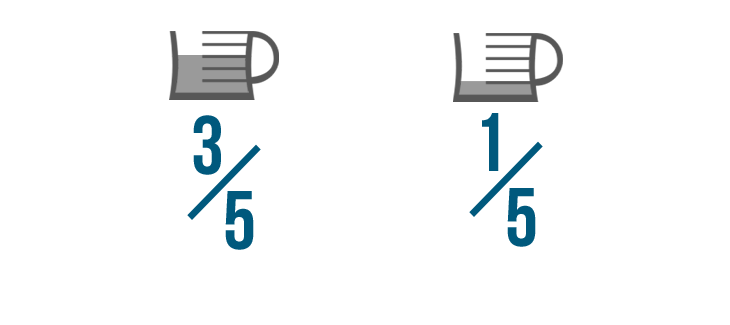
You also need 1/5 of a cup of oil to grease the pan. To see how much oil you'll need total, you can add these fractions together.
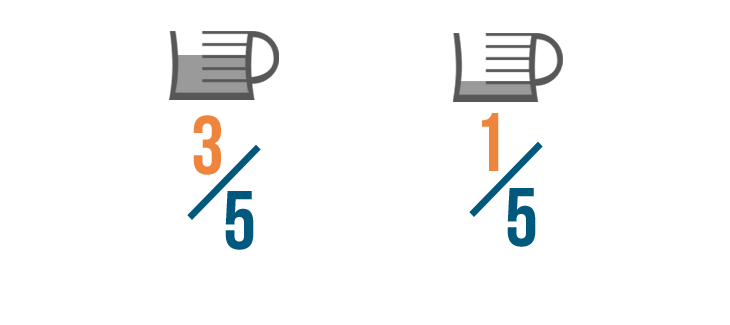
When you add fractions, you just add the top numbers, or numerators .
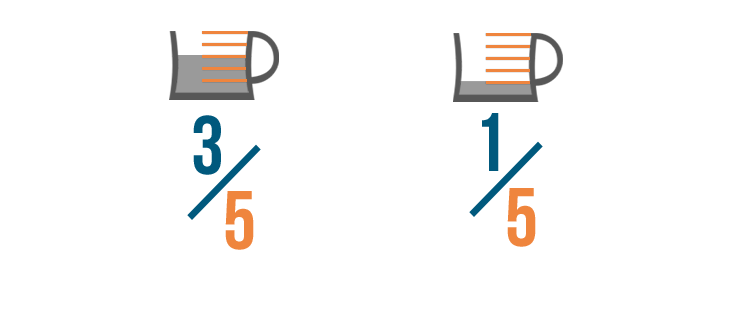
That's because the bottom numbers, or denominators , show how many parts would make a whole.
We don't want to change how many parts make a whole cup ( 5 ). We just want to find out how many parts we need total.
So we only need to add the numerators of our fractions.
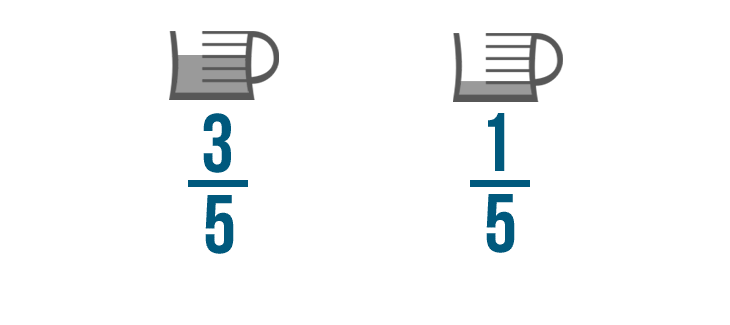
We can stack the fractions so the numerators are lined up. This will make it easier to add them.
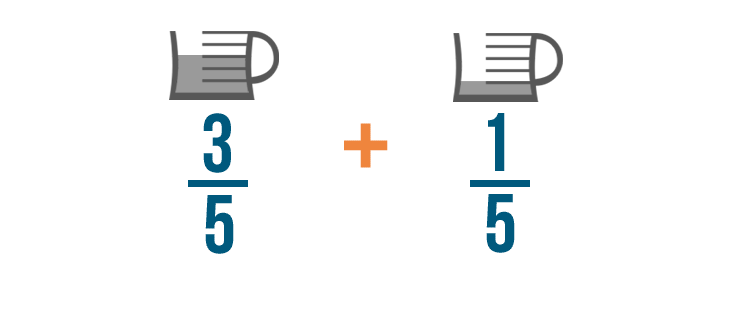
And that's all we have to do to set up an addition example with fractions. Our fractions are now ready to be added.

We'll do the same thing to set up a subtraction example. Let's say you had 3/4 of a tank of gas when you got to work.

If you use 1/4 of a tank to drive home, how much will you have left? We can subtract these fractions to find out.

Just like when we added, we'll stack our fractions to keep the numerators lined up.

This is because we want to subtract 1 part from 3 parts.

Now that our example is set up, we're ready to subtract!

Try setting up these addition and subtraction problems with fractions. Don't try solving them yet!
You run 4/10 of a mile in the morning. Later, you run for 3/10 of a mile.

You had 7/8 of a stick of butter and used 2/8 of the stick while cooking dinner.

Your gas tank is 2/5 full, and you put in another 2/5 of a tank.
Solving addition problems with fractions
Now that we know how to write addition problems with fractions, let's practice solving a few. If you can add whole numbers , you're ready to add fractions.
Click through the slideshow to learn how to add fractions.

Let's continue with our previous example and add these fractions: 3/5 of cup of oil and 1/5 of a cup of oil.
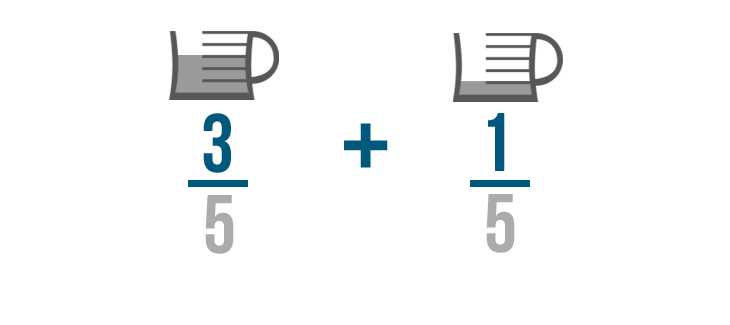
Remember, when we add fractions, we don't add the denominators.
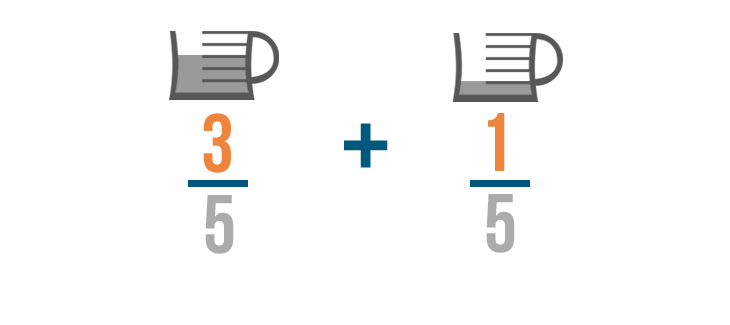
This is because we're finding how many parts we need total. The numerators show the parts we need, so we'll add 3 and 1 .
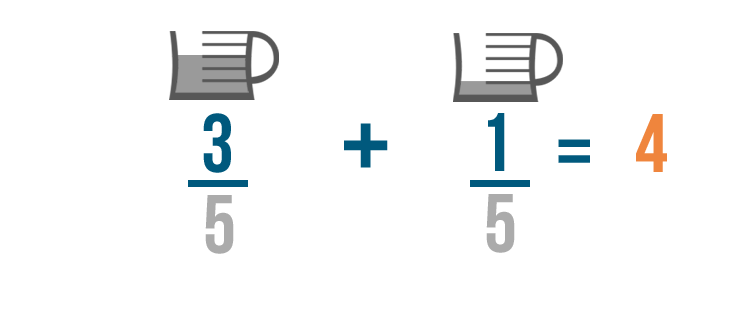
3 plus 1 equals 4 . Make sure to line up the 4 with the numbers you just added.
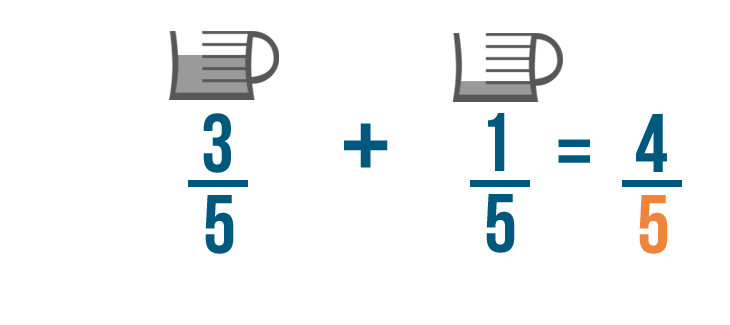
The denominators will stay the same, so we'll write 5 on the bottom of our new fraction.
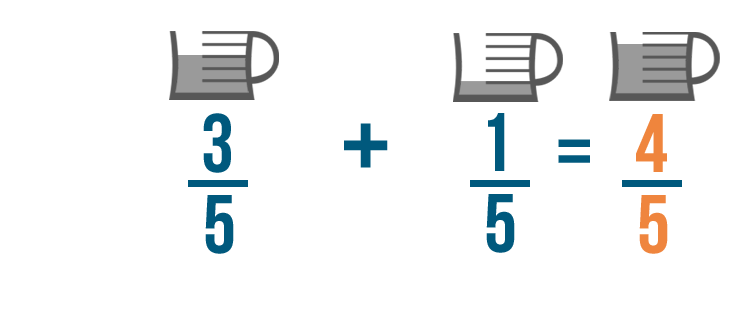
3/5 plus 1/5 equals 4/5 . So you'll need 4/5 of a cup of oil total to make your cake.

Let's try another example: 7/10 plus 2/10 .

Just like before, we're only going to add the numerators. In this example, the numerators are 7 and 2 .
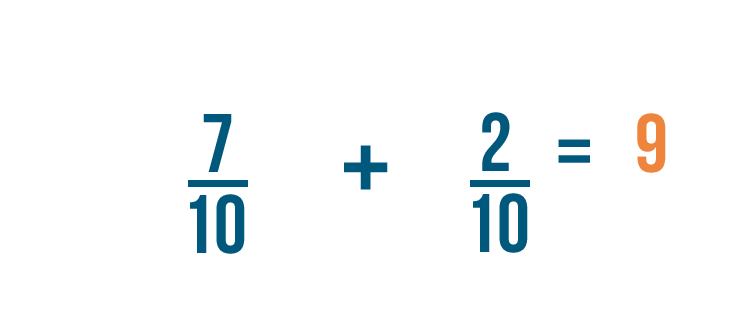
7 plus 2 equals 9 , so we'll write that to the right of the numerators.
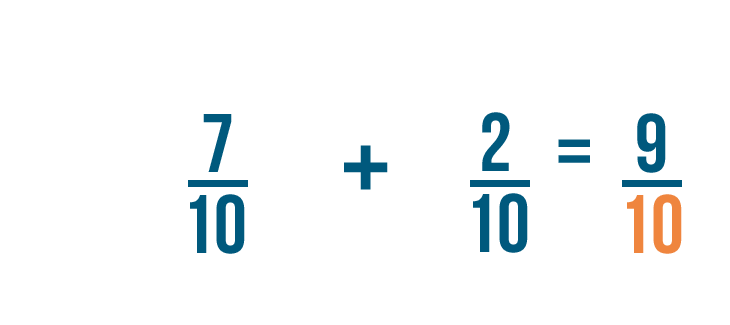
Just like in our earlier example, the denominator stays the same.
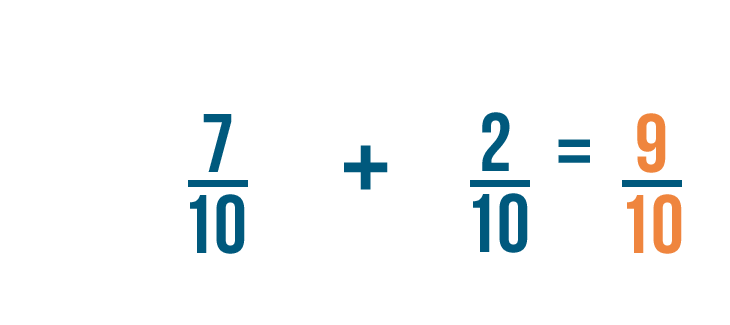
So 7/10 plus 2/10 equals 9/10 .
Try solving some of the addition problems below.
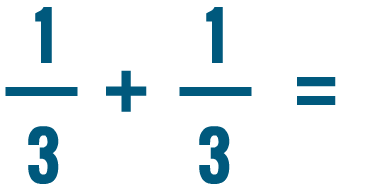
Solving subtraction problems with fractions
Subtracting fractions is a lot like regular subtraction. If you can subtract whole numbers , you can subtract fractions too!
Click through the slideshow to learn how to subtract fractions.

Let's use our earlier example and subtract 1/4 of a tank of gas from 3/4 of a tank.

Just like in addition, we're not going to change the denominators.

We don't want to change how many parts make a whole tank of gas. We just want to know how many parts we'll have left.
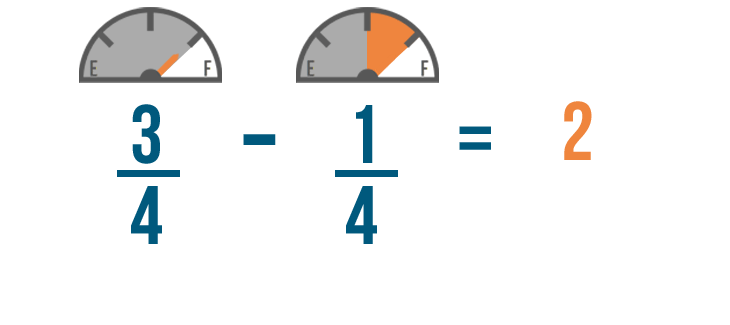
We'll start by subtracting the numerators. 3 minus 1 equals 2 , so we'll write 2 to the right of the numerators.

Just like when we added, the denominator of our answer will be the same as the other denominators.
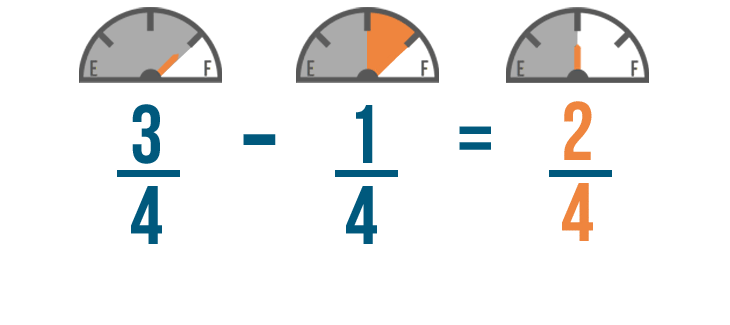
So 3/4 minus 1/4 equals 2/4 . You'll have 2/4 of a tank of gas left when you get home.

Let's try solving another problem: 5/6 minus 3/6 .

We'll start by subtracting the numerators.
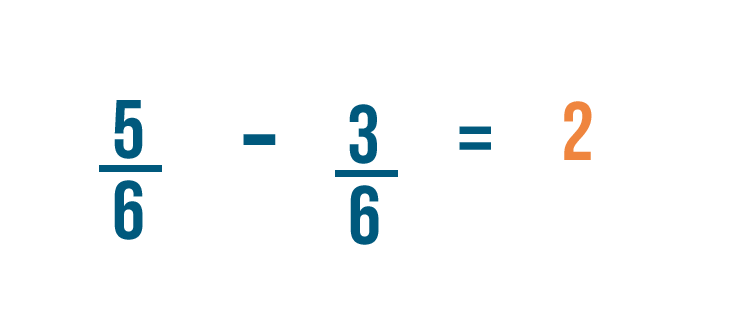
5 minus 3 equals 2 . So we'll put a 2 to the right of the numerators.
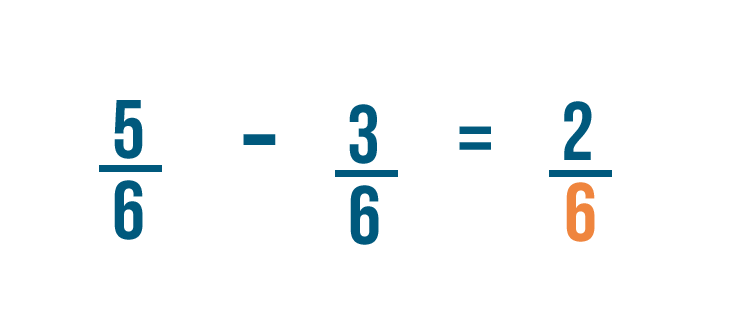
As usual, the denominator stays the same.
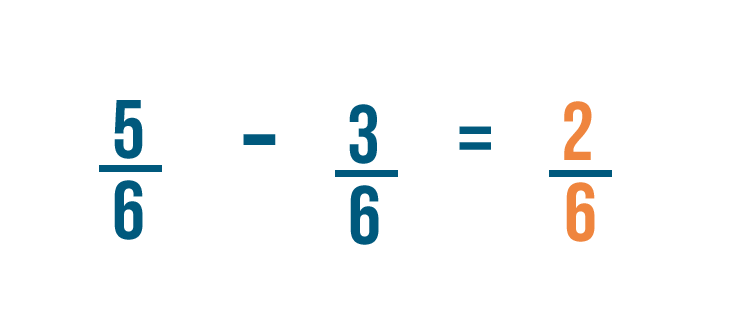
So 5/6 minus 3/6 equals 2/6 .
Try solving some of the subtraction problems below.
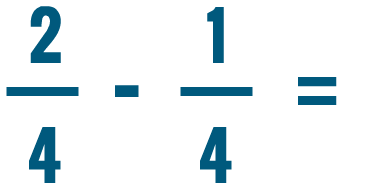
After you add or subtract fractions, you may sometimes have a fraction that can be reduced to a simpler fraction. As you learned in Comparing and Reducing Fractions , it's always best to reduce a fraction to its simplest form when you can. For example, 1/4 plus 1/4 equals 2/4 . Because 2 and 4 can both be divided 2 , we can reduce 2/4 to 1/2 .

Adding fractions with different denominators
On the last page, we learned how to add fractions that have the same denominator, like 1/4 and 3/4 . But what if you needed to add fractions with different denominators? For example, our cake recipe might say to blend 1/4 cup of milk in slowly and then dump in another 1/3 of a cup.
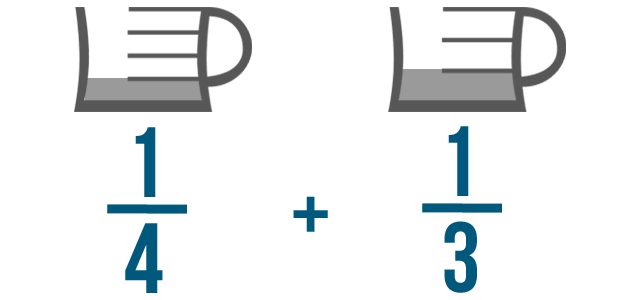
In Comparing and Reducing Fractions , we compared fractions with a different bottom number, or denominator. We had to change the fractions so their denominators were the same. To do that, we found the lowest common denominator , or LCD .
We can only add or subtract fractions if they have the same denominators. So we'll need to find the lowest common denominator before we add or subtract these fractions. Once the fractions have the same denominator, we can add or subtract as usual.
Click through the slideshow to learn how to add fractions with different denominators.
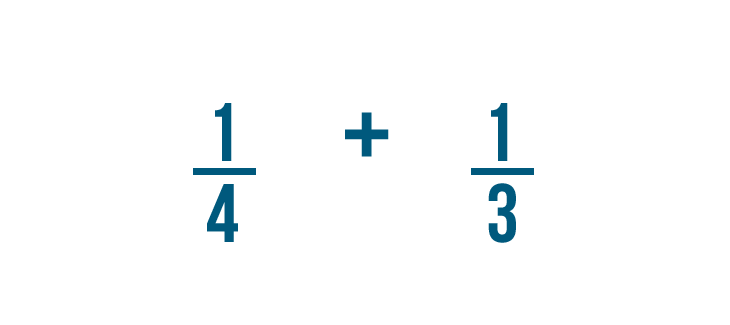
Let's add 1/4 and 1/3 .
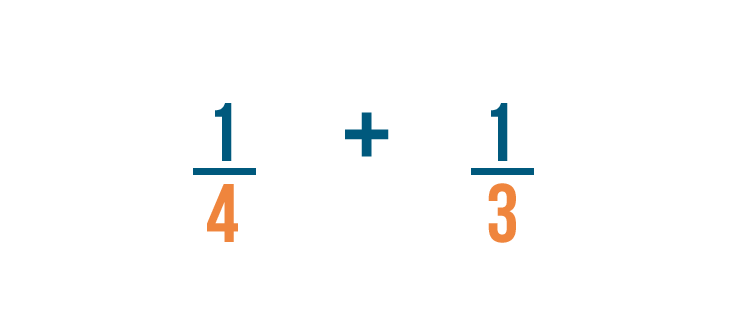
Before we can add these fractions, we'll need to change them so they have the same denominator .
To do that, we'll have to find the LCD , or lowest common denominator, of 4 and 3 .
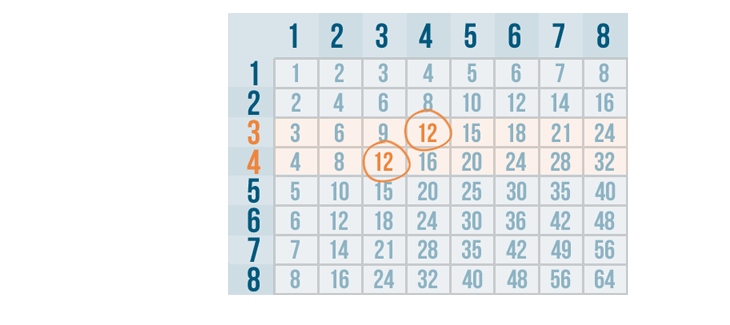
It looks like 12 is the smallest number that can be divided by both 3 and 4, so 12 is our LCD .
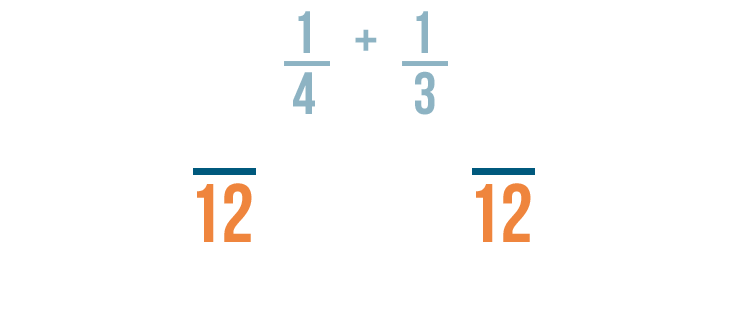
Since 12 is the LCD, it will be the new denominator for our fractions.
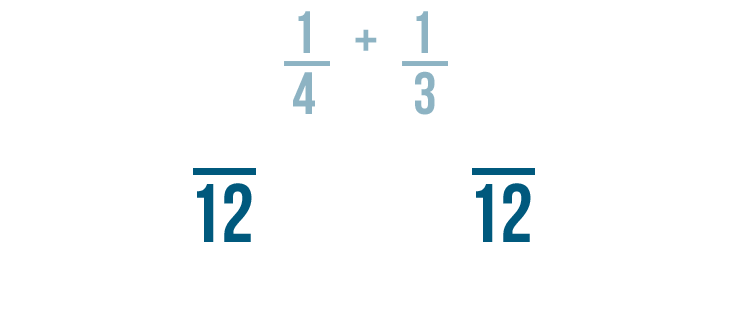
Now we'll change the numerators of the fractions, just like we changed the denominators.
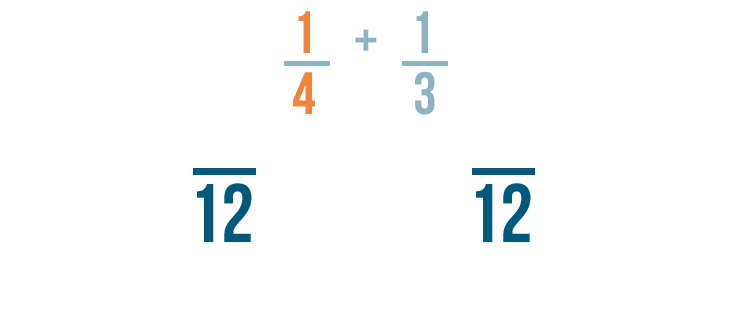
First, let's look at the fraction on the left: 1/4 .

To change 4 into 12 , we multiplied it by 3 .

Since the denominator was multiplied by 3 , we'll also multiply the numerator by 3 .
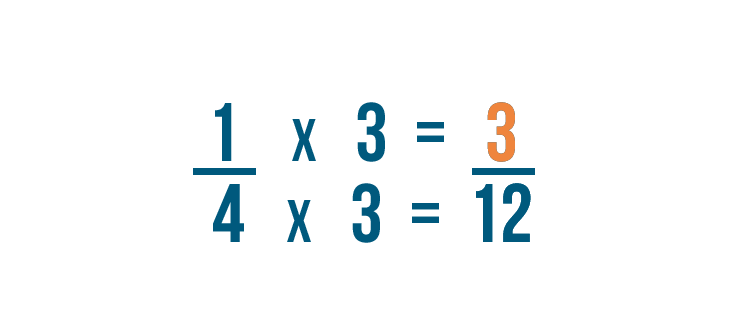
1 times 3 equals 3 .
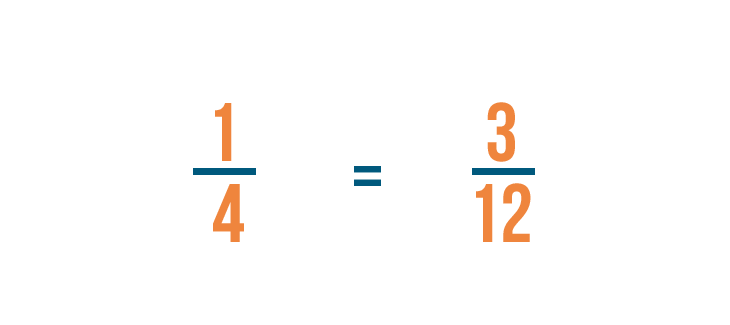
1/4 is equal to 3/12 .
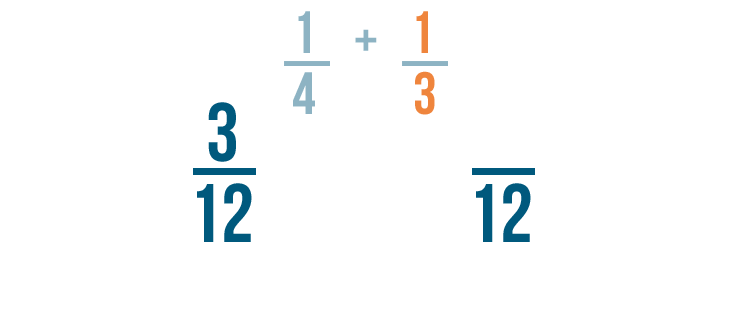
Now let's look at the fraction on the right: 1/3 . We changed its denominator to 12 as well.

Our old denominator was 3 . We multiplied it by 4 to get 12.
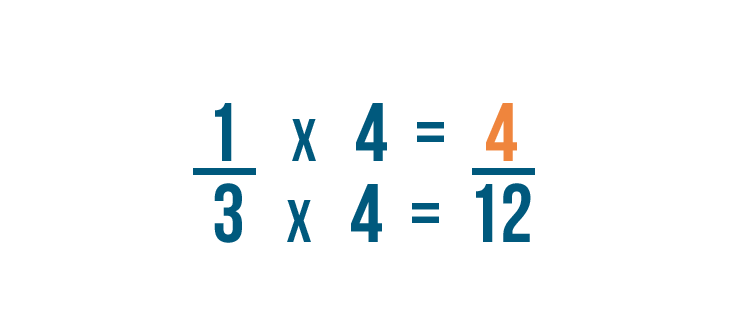
We'll also multiply the numerator by 4 . 1 times 4 equals 4 .
So 1/3 is equal to 4/12 .

Now that our fractions have the same denominator, we can add them like we normally do.
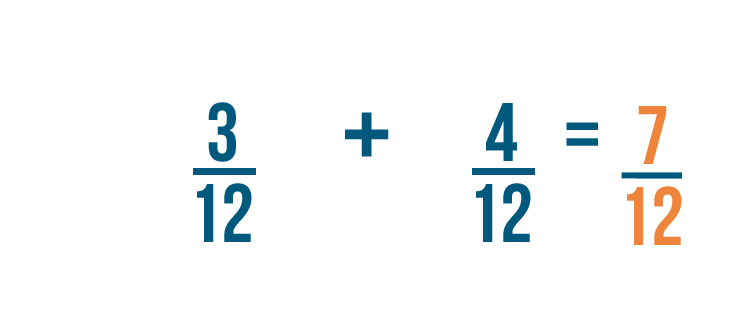
3 plus 4 equals 7 . As usual, the denominator stays the same. So 3/12 plus 4/12 equals 7/12 .
Try solving the addition problems below.
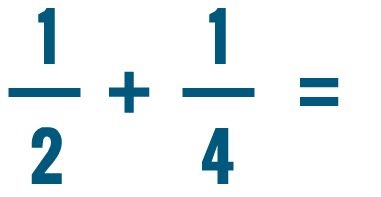

Subtracting fractions with different denominators
We just saw that fractions can only be added when they have the same denominator. The same thing is true when we're subtracting fractions. Before we can subtract, we'll have to change our fractions so they have the same denominator.
Click through the slideshow to learn how to subtract fractions with different denominators.
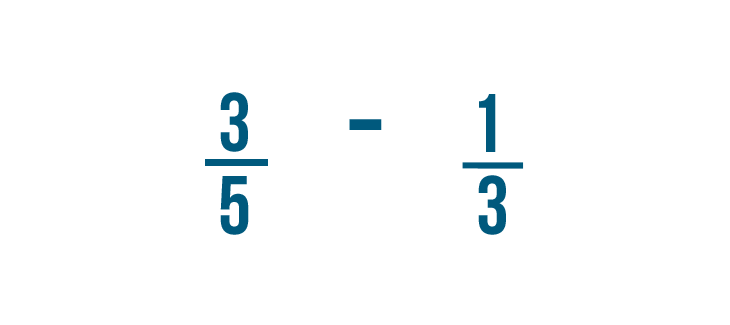
Let's try subtracting 1/3 from 3/5 .
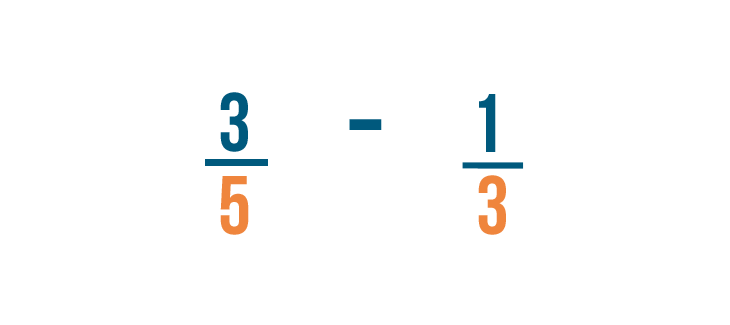
First, we'll change the denominators of both fractions to be the same by finding the lowest common denominator .

It looks like 15 is the smallest number that can be divided evenly by 3 and 5 , so 15 is our LCD.

Now we'll change our first fraction. To change the denominator to 15 , we'll multiply the denominator and the numerator by 3 .
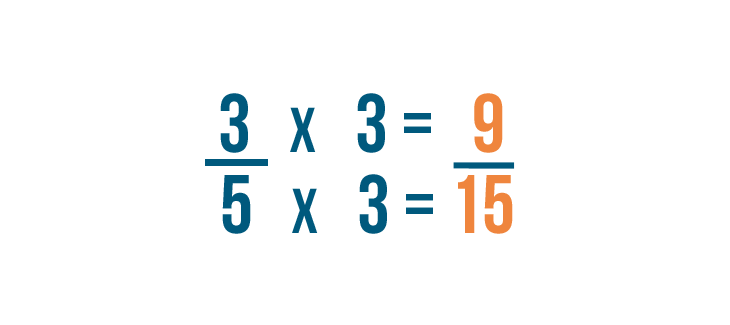
5 times 3 equals 15 . So our fraction is now 9/15 .
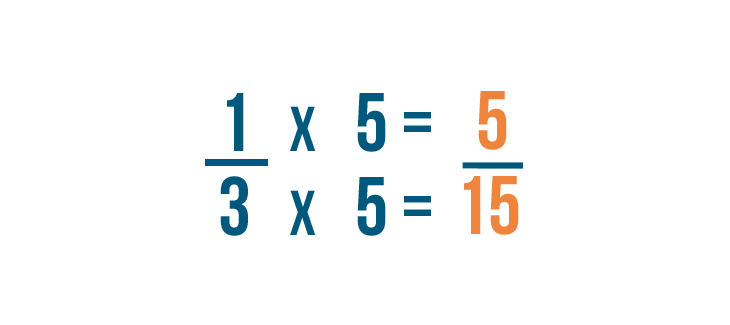
Now let's change the second fraction. To change the denominator to 15 , we'll multiply both numbers by 5 to get 5/15 .

Now that our fractions have the same denominator, we can subtract like we normally do.
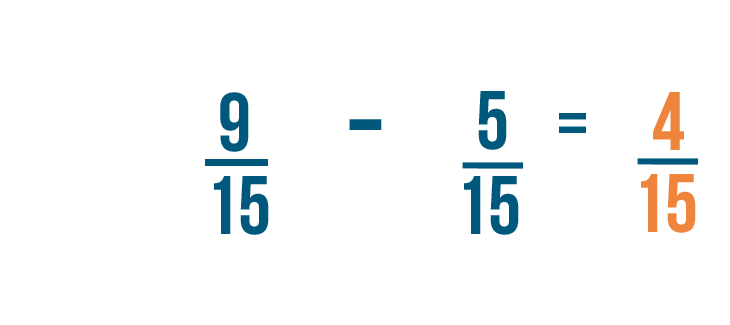
9 minus 5 equals 4 . As always, the denominator stays the same. So 9/15 minus 5/15 equals 4/15 .
Try solving the subtraction problems below.
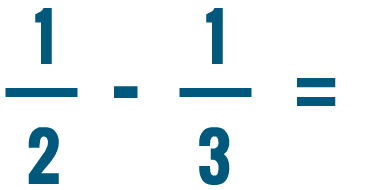
Adding and subtracting mixed numbers
Over the last few pages, you've practiced adding and subtracting different kinds of fractions. But some problems will need one extra step. For example, can you add the fractions below?
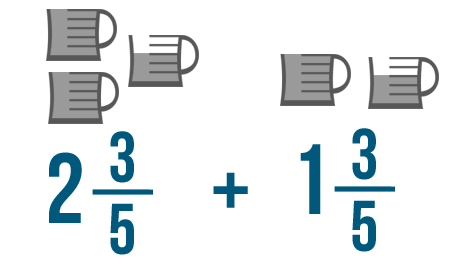
In Introduction to Fractions , you learned about mixed numbers . A mixed number has both a fraction and a whole number . An example is 2 1/2 , or two-and-a-half . Another way to write this would be 5/2 , or five-halves . These two numbers look different, but they're actually the same.
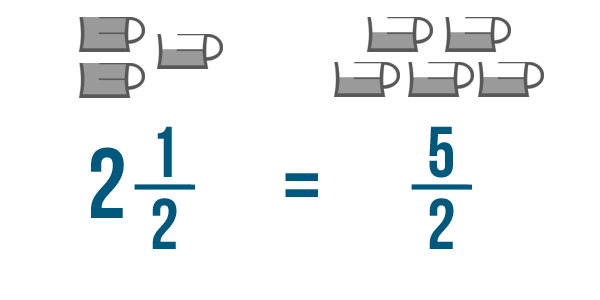
5/2 is an improper fraction . This just means the top number is larger than the bottom number. Even though improper fractions look strange, you can add and subtract them just like normal fractions. Mixed numbers aren't easy to add, so you'll have to convert them into improper fractions first.
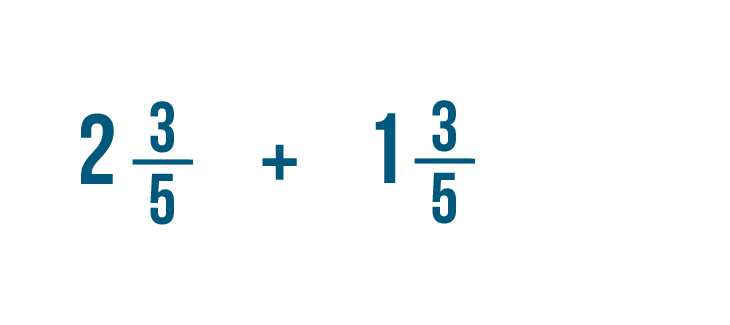
Let's add these two mixed numbers: 2 3/5 and 1 3/5 .
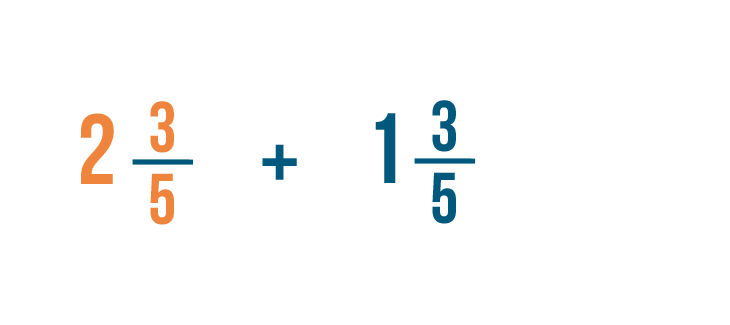
We'll need to convert these mixed numbers to improper fractions. Let's start with 2 3/5 .

As you learned in Lesson 2 , we'll multiply the whole number, 2 , by the bottom number, 5 .
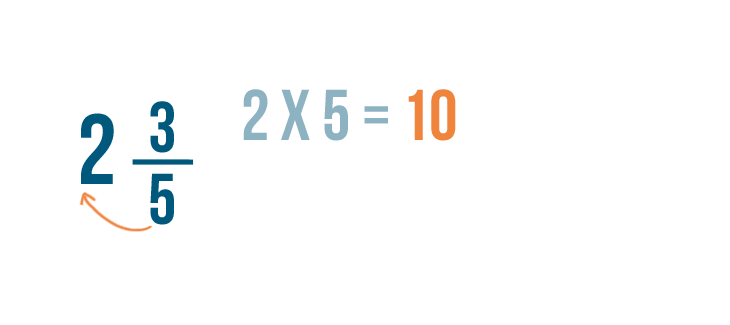
2 times 5 equals 10 .
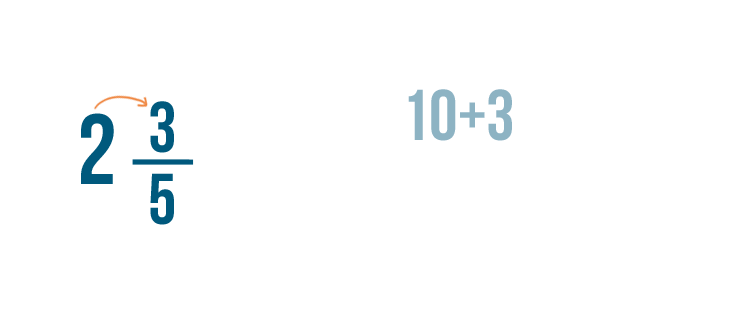
Now, let's add 10 to the numerator, 3 .

10 + 3 equals 13 .

Just like when you add fractions, the denominator stays the same. Our improper fraction is 13/5 .
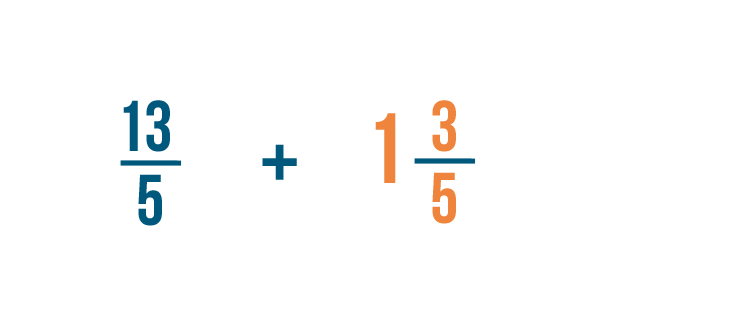
Now we'll need to convert our second mixed number: 1 3/5 .
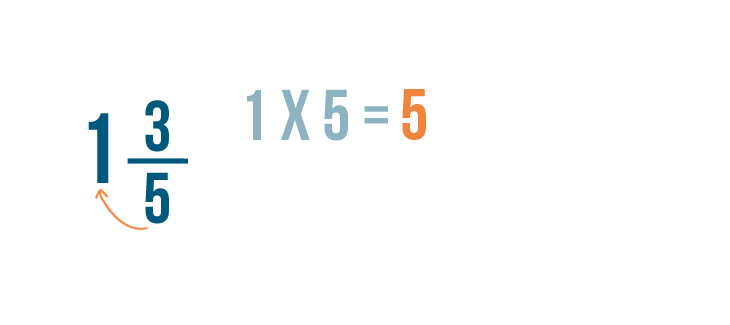
First, we'll multiply the whole number by the denominator. 1 x 5 = 5 .
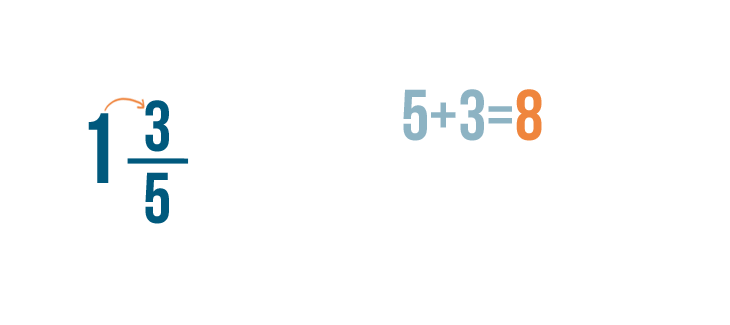
Next, we'll add 5 to the numerators. 5 + 3 = 8 .

Just like last time, the denominator remains the same. So we've changed 1 3/5 to 8/5 .
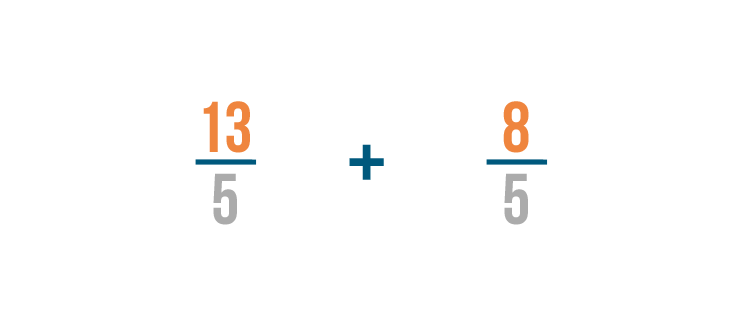
Now that we've changed our mixed numbers to improper fractions, we can add like we normally do.
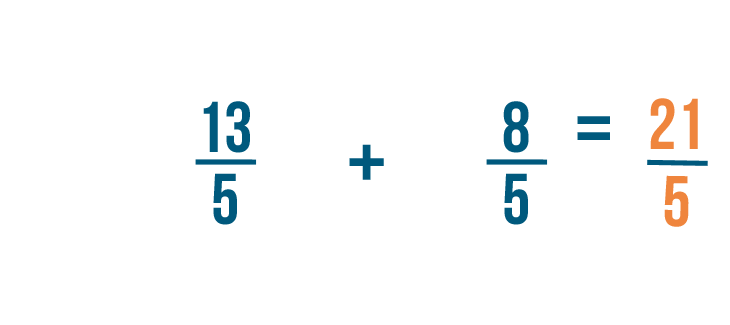
13 plus 8 equals 21 . As usual, the denominator will stay the same. So 13/5 + 8/5 = 21/5 .
Because we started with a mixed number, let's convert this improper fraction back into a mixed number.
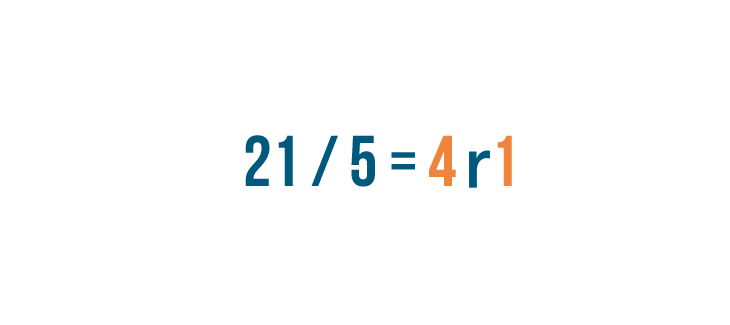
As you learned in the previous lesson , divide the top number by the bottom number. 21 divided by 5 equals 4, with a remainder of 1 .

The answer, 4, will become our whole number.

And the remainder , 1, will become the numerator of the fraction.
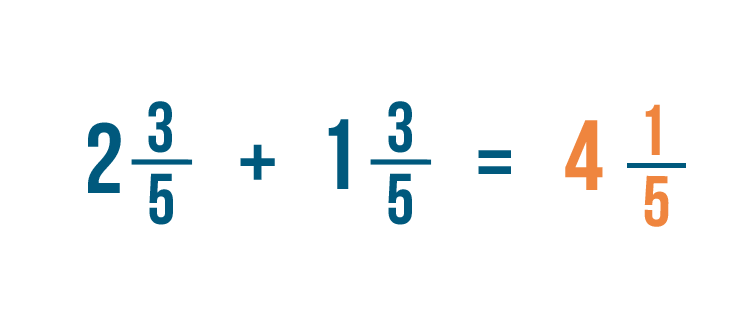
So 2 3/5 + 1 3/5 = 4 1/5 .
/en/fractions/multiplying-and-dividing-fractions/content/

Child Login
- Kindergarten
- Number charts
- Skip Counting
- Place Value
- Number Lines
- Subtraction
- Multiplication
- Word Problems
- Comparing Numbers
- Ordering Numbers
- Odd and Even
- Prime and Composite
- Roman Numerals
- Ordinal Numbers
- In and Out Boxes
- Number System Conversions
- More Number Sense Worksheets
- Size Comparison
- Measuring Length
- Metric Unit Conversion
- Customary Unit Conversion
- Temperature
- More Measurement Worksheets
- Writing Checks
- Profit and Loss
- Simple Interest
- Compound Interest
- Tally Marks
- Mean, Median, Mode, Range
- Mean Absolute Deviation
- Stem-and-leaf Plot
- Box-and-whisker Plot
- Permutation and Combination
- Probability
- Venn Diagram
- More Statistics Worksheets
- Shapes - 2D
- Shapes - 3D
- Lines, Rays and Line Segments
- Points, Lines and Planes
- Transformation
- Quadrilateral
- Ordered Pairs
- Midpoint Formula
- Distance Formula
- Parallel, Perpendicular and Intersecting Lines
- Scale Factor
- Surface Area
- Pythagorean Theorem
- More Geometry Worksheets
- Converting between Fractions and Decimals
- Significant Figures
- Convert between Fractions, Decimals, and Percents
- Proportions
- Direct and Inverse Variation
- Order of Operations
- Squaring Numbers
- Square Roots
- Scientific Notations
- Speed, Distance, and Time
- Absolute Value
- More Pre-Algebra Worksheets
- Translating Algebraic Phrases
- Evaluating Algebraic Expressions
- Simplifying Algebraic Expressions
- Algebraic Identities
- Quadratic Equations
- Systems of Equations
- Polynomials
- Inequalities
- Sequence and Series
- Complex Numbers
- More Algebra Worksheets
- Trigonometry
- Math Workbooks
- English Language Arts
- Summer Review Packets
- Social Studies
- Holidays and Events
- Worksheets >
- Pre-Algebra >
- Fractions >
Fraction Word Problem Worksheets
Featured here is a vast collection of fraction word problems, which require learners to simplify fractions, add like and unlike fractions; subtract like and unlike fractions; multiply and divide fractions. The fraction word problems include proper fraction, improper fraction, and mixed numbers. Solve each word problem and scroll down each printable worksheet to verify your solutions using the answer key provided. Thumb through some of these word problem worksheets for free!
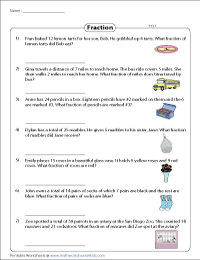
Represent and Simplify the Fractions: Type 1
Presented here are the fraction pdf worksheets based on real-life scenarios. Read the basic fraction word problems, write the correct fraction and reduce your answer to the simplest form.
- Download the set
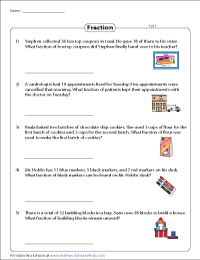
Represent and Simplify the Fractions: Type 2
Before representing in fraction, children should perform addition or subtraction to solve these fraction word problems. Write your answer in the simplest form.
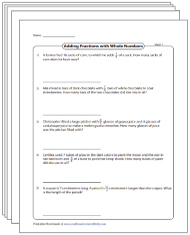
Adding Fractions Word Problems Worksheets
Conjure up a picture of how adding fractions plays a significant role in our day-to-day lives with the help of the real-life scenarios and circumstances presented as word problems here.
(15 Worksheets)
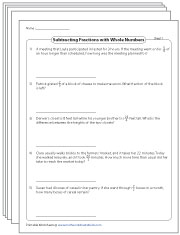
Subtracting Fractions Word Problems Worksheets
Crank up your skills with this set of printable worksheets on subtracting fractions word problems presenting real-world situations that involve fraction subtraction!
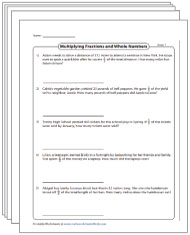
Multiplying Fractions Word Problems Worksheets
This set of printables is for the ardently active children! Explore the application of fraction multiplication and mixed-number multiplication in the real world with this exhilarating practice set.
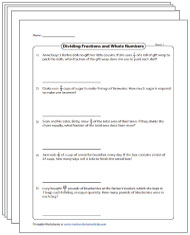
Fraction Division Word Problems Worksheets
Gift children a broad view of the real-life application of dividing fractions! Let them divide fractions by whole numbers, divide 2 fractions, divide mixed numbers, and solve the word problems here.
Related Worksheets
» Decimal Word Problems
» Ratio Word Problems
» Division Word Problems
» Math Word Problems
Become a Member
Membership Information
Privacy Policy
What's New?
Printing Help
Testimonial
Copyright © 2024 - Math Worksheets 4 Kids
This is a members-only feature!


- school Campus Bookshelves
- menu_book Bookshelves
- perm_media Learning Objects
- login Login
- how_to_reg Request Instructor Account
- hub Instructor Commons
- Download Page (PDF)
- Download Full Book (PDF)
- Periodic Table
- Physics Constants
- Scientific Calculator
- Reference & Cite
- Tools expand_more
- Readability
selected template will load here
This action is not available.

4.9: Solving Equations with Fractions
- Last updated
- Save as PDF
- Page ID 24084

- David Arnold
- College of the Redwoods
Undoing Subtraction
We can still add the same amount to both sides of an equation without changing the solution.
Solve for x : \(x - \frac{5}{6} = \frac{1}{3}\).
To “undo” subtracting 5/6, add 5/6 to both sides of the equation and simplify.
\[ \begin{aligned} x - \frac{5}{6} = \frac{1}{3} ~ & \textcolor{red}{ \text{ Original equation.}} \\ x - \frac{5}{6} + \frac{5}{6} = \frac{1}{3} + \frac{5}{6} ~ & \textcolor{red}{ \text{ Add } \frac{5}{6} \text{ to both sides.}} \\ x = \frac{1 \cdot 2}{3 \cdot 2} + \frac{5}{6} ~ & \textcolor{red}{ \text{ Equivalent fractions, LCD = 6.}} \\ x = \frac{2}{6} + \frac{5}{6} ~ & \textcolor{red}{ \text{ Simplify.}} \\ x = \frac{7}{6} ~ & \textcolor{red}{ \text{ Add.}} \end{aligned}\nonumber \]
It is perfectly acceptable to leave your answer as an improper fraction. If you desire, or if you are instructed to do so, you can change your answer to a mixed fraction (7 divided by 6 is 1 with a remainder of 1). That is \(x = 1 \frac{1}{6}\).
Checking the Solution
Substitute 7/6 for x in the original equation and simplify.
\[ \begin{aligned} x - \frac{5}{6} = \frac{1}{3} ~ & \textcolor{red}{ \text{ Original equation.}} \\ \frac{7}{6} - \frac{5}{6} = \frac{1}{3} ~ & \textcolor{red}{ \text{ Substitute 7/6 for } x.} \\ \frac{2}{6} = \frac{1}{3} ~ & \textcolor{red}{ \text{ Subtract.}} \\ \frac{1}{3} = \frac{1}{3} ~ & \textcolor{red}{ \text{ Reduce.}} \end{aligned}\nonumber \]
Because the last statement is true, we conclude that 7/6 is a solution of the equation x − 5/6 = 1/3.
Undoing Addition
You can still subtract the same amount from both sides of an equation without changing the solution.
Solve for x : \(x + \frac{2}{3} = - \frac{3}{5}\).
To “undo” adding 2/3, subtract 2/3 from both sides of the equation and simplify.
\[ \begin{aligned} x + \frac{2}{3} = - \frac{3}{5} ~ & \textcolor{red}{ \text{ Original equation.}} \\ x + \frac{2}{3} - \frac{2}{3} = - \frac{3}{5} - \frac{2}{3} ~ & \textcolor{red}{ \text{ Subtract } \frac{2}{3} \text{ from both sides.}} \\ x = - \frac{3 \cdot 3}{5 \cdot 3} - \frac{2 \cdot 5}{3 \cdot 5} ~ & \textcolor{red}{ \text{ Equivalent fractions, LCD = 15.}} \\ x = - \frac{9}{15} - \frac{10}{15} ~ & \textcolor{red}{ \text{ Simplify.}} \\ x = - \frac{19}{15} ~ & \textcolor{red}{ \text{ Subtract.}} \end{aligned}\nonumber \]
Readers are encouraged to check this solution in the original equation.
Solve for x : \(x + \frac{3}{4} = - \frac{1}{2}\)
Undoing Multiplication
We “undo” multiplication by dividing. For example, to solve the equation 2 x = 6, we would divide both sides of the equation by 2. In similar fashion, we could divide both sides of the equation
\[ \frac{3}{5} x = \frac{4}{10}\nonumber \]
by 3/5. However, it is more efficient to take advantage of reciprocals. For convenience, we remind readers of the Multiplicative Inverse Property .
Multiplicative Inverse Property
Let a / b be any fraction. The number b / a is called the multiplicative inverse or reciprocal of a / b . The product of reciprocals is 1.
\[ \frac{a}{b} \cdot \frac{b}{a} = 1.\nonumber \]
Let’s put our knowledge of reciprocals to work.
Solve for x : \(\frac{3}{5}x = \frac{4}{10}\).
To “undo” multiplying by 3/5, multiply both sides by the reciprocal 5/3 and simplify.
\[ \begin{aligned} \frac{3}{5} x = \frac{4}{10} ~ & \textcolor{red}{ \text{ Original equation.}} \\ \frac{5}{3} \left( \frac{3}{5} x \right) = \frac{5}{3} \left( \frac{4}{10} \right) & ~ \textcolor{red}{ \text{ Multiply both sides by 5/3.}} \\ \left( \frac{5}{3} \cdot \frac{3}{5} \right) x = \frac{20}{30} ~ & \textcolor{red}{ \begin{array}{l} \text{ On the left, use the associative property to regroup.} \\ \text{ On the right, multiply.} \end{array}} \\ 1x = \frac{2}{3} ~ & \textcolor{red}{ \begin{array}{l} \text{ On the left, } \frac{5}{3} \cdot \frac{3}{5} = 1. \\ \text{ On the right, reduce: } \frac{20}{30} = \frac{2}{3}. \end{array}} \\ x = \frac{2}{3} ~ & \textcolor{red}{ \text{ On the left, } 1x = x.} \end{aligned}\nonumber \]
Substitute 2/3 for x in the original equation and simplify.
\[ \begin{aligned} \frac{3}{5} x = \frac{4}{10} ~ & \textcolor{red}{ \text{ Original equation.}} \\ \frac{3}{5} \left( \frac{2}{3} \right) = \frac{4}{10} ~ & \textcolor{red}{ \text{ Substitute 2/3 for }x.} \\ \frac{6}{15} = \frac{4}{10} ~ & \textcolor{red}{ \text{ Multiply numerators; multiply denominators.}} \\ \frac{2}{5} = \frac{2}{5} ~ & \textcolor{red}{ \text{ Reduce both sides to lowest terms.}} \end{aligned}\nonumber \]
Because this last statement is true, we conclude that 2/3 is a solution of the equation (3/5) x = 4/10.
Solve for y : \( \frac{2}{3} y = \frac{4}{5}\)
Solve for x : \(- \frac{8}{9} x = \frac{5}{18}\).
To “undo” multiplying by −8/9, multiply both sides by the reciprocal −9/8 and simplify.
\[ \begin{aligned} - \frac{8}{9} x = \frac{5}{18} ~ & \textcolor{red}{ \text{ Original equation.}} \\ - \frac{9}{8} \left( - \frac{8}{9} x \right) = - \frac{9}{8} \left( \frac{5}{18} \right) ~ & \textcolor{red}{ \text{ Multiply both sides by } -9/8.} \\ \left[ - \frac{9}{8} \cdot \left( - \frac{8}{9} \right) \right] x = - \frac{3 \cdot 3}{2 \cdot 2 \cdot 2} \cdot \frac{5}{2 \cdot 3 \cdot 3} ~ & \textcolor{red}{ \begin{array}{l} \text{ On the left, use the associative property to regroup.} \\ \text{ On the right, prime factor.} \end{array}} 1x = \frac{ \cancel{3} \cdot \cancel{3}}{2 \cdot 2 \cdot 2} \cdot \frac{5}{2 \cdot \cancel{3} \cdot \cancel{3}} ~ & \textcolor{red}{ \begin{array}{l} \text{ On the left, } - \frac{9}{8} \cdot \left( - \frac{8}{9} \right) = 1. \\ \text{ On the right, cancel common factors.} \end{array}} \\ x = - \frac{5}{16} ~ & \textcolor{red}{ \text{ On the left, } 1x = x. \text{ Multiply on the right.}} \end{aligned}\nonumber \]
Solve for z: \(− \frac{2}{7} z = \frac{4}{21}\)
Clearing Fractions from the Equation
Although the technique demonstrated in the previous examples is a solid mathematical technique, working with fractions in an equation is not always the most efficient use of your time.
To clear all fractions from an equation, multiply both sides of the equation by the least common denominator of the fractions that appear in the equation.
Let’s put this idea to work.
In Example 1, we were asked to solve the following equation for x :
\[x - \frac{5}{6} = \frac{1}{3}.\nonumber \]
Take a moment to review the solution technique in Example 1. We will now solve this equation by first clearing all fractions from the equation.
Multiply both sides of the equation by the least common denominator for the fractions appearing in the equation.
\[ \begin{aligned} x - \frac{5}{6}= \frac{1}{3} ~ & \textcolor{red}{ \text{ Original equation.}} \\ 6 \left( x - \frac{5}{6} \right) = 6 \left( \frac{1}{3} \right) ~ & \textcolor{red}{ \text{ Multiply both sides by 6.}} \\ 6x - 6 \left( \frac{5}{6} \right) = 6 \left( \frac{1}{3} \right) ~ & \textcolor{red}{ \text{ Distribute the 6.}} \\ 6x-5 = 2 ~ & \textcolor{red}{ \text{ On each side, multiply first.}} \\ ~ & \textcolor{red}{6 \left( \frac{5}{6} \right) = 5 \text{ and } 6 \left( \frac{1}{3} \right) = 2.} \end{aligned}\nonumber \]
Note that the equation is now entirely clear of fractions, making it a much simpler equation to solve.
\[ \begin{aligned} 6x - 5 + 5 = 2 + 5 ~ & \textcolor{red}{ \text{ Add 5 to both sides.}} \\ 6x = 7 ~ & \textcolor{red}{ \text{ Simplify both sides.}} \\ \frac{6x}{6} = \frac{7}{6} ~ & \textcolor{red}{ \text{ Divide both sides by 6.}} \\ x = \frac{7}{6} ~ & \textcolor{red}{ \text{ Simplify.}} \end{aligned}\nonumber \]
Note that this is the same solution found in Example 1.
Solve for t : \(t - \frac{2}{7} = - \frac{1}{4}\)
In Example 4, we were asked to solve the following equation for x .
\[- \frac{8}{9}x = \frac{5}{18}\nonumber \]
Take a moment to review the solution in Example 4. We will now solve this equation by first clearing all fractions from the equation.
Multiply both sides of the equation by the least common denominator for the fractions that appear in the equation.
\[ \begin{aligned} - \frac{8}{9} x = \frac{5}{18} ~ & \textcolor{red}{ \text{ Original equation.}} \\ 18 \left( - \frac{8}{9} x \right) = 18 \left( \frac{5}{18} \right) ~ & \textcolor{red}{ \text{ Multiply both sides by 18.}} \\ -16x=5 ~ & \textcolor{red}{ \text{ On each side, cancel and multiply.}} \\ ~ & \textcolor{red}{ 18 \left( - \frac{8}{9} \right) = -16 \text{ and } 18 \left( \frac{5}{18} \right) = 5.} \end{aligned}\nonumber \]
Note that the equation is now entirely free of fractions. Continuing,
\[ \begin{aligned} \frac{-16x}{-16} = \frac{5}{-16} ~ & \textcolor{red}{ \text{ Divide both sides by } -16.} \\ x = - \frac{5}{16} ~ & \textcolor{red}{ \text{ Simplify.}} \end{aligned}\nonumber \]
Note that this is the same as the solution found in Example 4.
Solve for u :
\[ - \frac{7}{9} u = \frac{14}{27}\nonumber \]
Solve for x : \(\frac{2}{3}x + \frac{3}{4} = \frac{1}{2}\).
\[ \begin{aligned} \frac{2}{3} x + \frac{3}{4} = \frac{1}{2} ~ & \textcolor{red}{ \text{ Original equation.}} \\ 12 \left( \frac{2}{3} x + \frac{3}{4} = \right) = 12 \left( \frac{1}{2} \right) ~ & \textcolor{red}{ \text{ Multiply both sides by 12.}} \\ 12 \left( \frac{2}{3}x \right) + 12 \left( \frac{3}{4} \right) = 12 \left( \frac{1}{2} \right) ~ & \textcolor{red}{ \text{ On the left, distribute 12.}} \\ 8x + 9 = 6 ~ & \textcolor{red}{ \text{ Multiply: } 12 \left( \frac{2}{3} x \right) = 8x, ~ 12 \left( \frac{3}{4} \right) = 9,} \\ ~ & \textcolor{red}{ \text{ and } 12 \left( \frac{1}{2} \right) = 6.} \end{aligned}\nonumber \]
Note that the equation is now entirely free of fractions. We need to isolate the terms containing x on one side of the equation.
\[ \begin{aligned} 8x + 9 - 9 = 6 - 9 ~ & \textcolor{red}{ \text{ Subtract 9 from both sides.}} \\ 8x = - 3 ~ & \textcolor{red}{ \text{ Simplify both sides.}} \\ \frac{8x}{8} = \frac{-3}{8} ~ & \textcolor{red}{ \text{ Divide both sides by 8.}} \\ x = - \frac{3}{8} ~ & \textcolor{red}{ \text{ Simplify both sides.}} \end{aligned}\nonumber \]
Solve for r : \(\frac{3}{4} r + \frac{2}{3} = \frac{1}{2}\)
Solve for x : \( \frac{2}{3} - \frac{3x}{4} = \frac{x}{2} - \frac{1}{8}.\)
Multiply both sides of the equation by the least common denominator for the fractions in the equation.
\[ \begin{aligned} \frac{2}{3} - \frac{3x}{4} = \frac{x}{2} - \frac{1}{8} ~ & \textcolor{red}{ \text{ Original equation.}} \\ 24 \left( \frac{2}{3} - \frac{3x}{4} \right) = 24 \left( \frac{x}{2} - \frac{1}{8} \right) ~ & \textcolor{red}{ \text{ Multiply both sides by 24.}} \\ 24 \left( \frac{2}{3} \right) - 24 \left( \frac{3x}{4} \right) = 24 \left( \frac{x}{2} \right) - 24 \left( \frac{1}{8} \right) ~ & \textcolor{red}{ \text{ On both sides, distribute 24.}} \\ 16 - 18x = 12x - 3 ~ & \textcolor{red}{ \text{ Left: } 24 \left( \frac{2}{3} \right) = 16, ~ 24 \left( \frac{3x}{4} \right) = 18x.} \\ ~ & \textcolor{red}{ \text{ Right: } 24 \left( \frac{x}{2} \right) = 12x, ~ 24 \left( \frac{1}{8} \right) = 3.} \end{aligned}\nonumber \]
\[ \begin{aligned} 16 - 18x - 12x = 12x - 3 - 12x ~ & \textcolor{red}{ \text{ Subtract } 12x \text{ from both sides.}} \\ 16 - 30x = -3 ~ & \textcolor{red}{ \begin{aligned} \text{ Left: } -18x - 12x = -30x. \\ \text{ Right: } 12x - 12x = 0. \end{aligned}} \\ 16 - 30x - 16 = -3 - 16 ~ & \textcolor{red}{ \text{ Subtract 16 from both sides.}} \\ -30x = -19 ~ & \textcolor{red}{ \begin{aligned} \text{ Left: } 16-16=0. \\ \text{ Right: } -3 - 16 = -19. \end{aligned}} \\ \frac{-30x}{-30} = \frac{-19}{-30} ~ & \textcolor{red}{ \text{ Divide both sides by } -30.} \\ x = \frac{19}{30} ~ & \textcolor{red}{ \text{ Simplify both sides.}} \end{aligned}\nonumber \]
Solve for s : \( \frac{3}{2} - \frac{2s}{5} = \frac{s}{3} - \frac{1}{5}\).
Add texts here. Do not delete this text first.
Solver Title
Generating PDF...
- Pre Algebra Order of Operations Factors & Primes Fractions Long Arithmetic Decimals Exponents & Radicals Ratios & Proportions Percent Modulo Number Line Expanded Form Mean, Median & Mode
- Algebra Equations Inequalities System of Equations System of Inequalities Basic Operations Algebraic Properties Partial Fractions Polynomials Rational Expressions Sequences Power Sums Interval Notation Pi (Product) Notation Induction Logical Sets Word Problems
- Pre Calculus Equations Inequalities Scientific Calculator Scientific Notation Arithmetics Complex Numbers Polar/Cartesian Simultaneous Equations System of Inequalities Polynomials Rationales Functions Arithmetic & Comp. Coordinate Geometry Plane Geometry Solid Geometry Conic Sections Trigonometry
- Calculus Derivatives Derivative Applications Limits Integrals Integral Applications Integral Approximation Series ODE Multivariable Calculus Laplace Transform Taylor/Maclaurin Series Fourier Series Fourier Transform
- Functions Line Equations Functions Arithmetic & Comp. Conic Sections Transformation
- Linear Algebra Matrices Vectors
- Trigonometry Identities Proving Identities Trig Equations Trig Inequalities Evaluate Functions Simplify
- Statistics Mean Geometric Mean Quadratic Mean Average Median Mode Order Minimum Maximum Probability Mid-Range Range Standard Deviation Variance Lower Quartile Upper Quartile Interquartile Range Midhinge Standard Normal Distribution
- Physics Mechanics
- Chemistry Chemical Reactions Chemical Properties
- Finance Simple Interest Compound Interest Present Value Future Value
- Economics Point of Diminishing Return
- Conversions Roman Numerals Radical to Exponent Exponent to Radical To Fraction To Decimal To Mixed Number To Improper Fraction Radians to Degrees Degrees to Radians Hexadecimal Scientific Notation Distance Weight Time Volume
- Pre Algebra
- Two-step without parentheses
- Two-step with parentheses
- Three/four steps without parentheses
- Three/four steps with parentheses
- Multi-step without parentheses
- Multi-step with parentheses
- Prime Factorization
- Negative Factors
- Positive Factors
- Odd Factors
- Even Factors
- Biggest Factor
- Equivalent Fractions
- Add, Subtract
- Add, Subtract Like Denominators
- Add, Subtract Unlike Denominators
- Multiply with Whole Number
- Divide with Whole Number
- Mixed Numbers
- Complex Fractions
- Improper Fractions
- Long Addition
- Long Subtraction
- Long Multiplication
- Long Division
- Add/Subtract
- Multiplication
- Decimal to Fraction
- Fraction to Decimal
- Square Root
- Ratios & Proportions
Number Line
- Expanded Form
- Pre Calculus
- Linear Algebra
- Trigonometry
- Conversions

Most Used Actions
- reduce\:fraction\:\frac{4}{8}
- \frac{1}{2}+\frac{1}{4}+\frac{3}{4}
- \frac{1}{2}\cdot\frac{8}{7}
- \frac{-\frac{1}{5}}{\frac{7}{4}}
- descending\:order\:\frac{1}{2},\:\frac{3}{6},\:\frac{7}{2}
- decimal\:to\:fraction\:0.35
- What is a mixed number?
- A mixed number is a combination of a whole number and a fraction.
- How can I compare two fractions?
- To compare two fractions, first find a common denominator, then compare the numerators.Alternatively, compare the fractions by converting them to decimals.
- How do you add or subtract fractions with different denominators?
- To add or subtract fractions with different denominators, convert the fractions to have a common denominator. Then you can add or subtract the numerators of the fractions, leaving the denominator unchanged.
fractions-calculator
- My Notebook, the Symbolab way Math notebooks have been around for hundreds of years. You write down problems, solutions and notes to go back...
Please add a message.
Message received. Thanks for the feedback.
Fractions Worksheets
Welcome to the fractions worksheets page at Math-Drills.com where the cup is half full! This is one of our more popular pages most likely because learning fractions is incredibly important in a person's life and it is a math topic that many approach with trepidation due to its bad rap over the years. Fractions really aren't that difficult to master especially with the support of our wide selection of worksheets.
This page includes Fractions worksheets for understanding fractions including modeling, comparing, ordering, simplifying and converting fractions and operations with fractions. We start you off with the obvious: modeling fractions. It is a great idea if students can actually understand what a fraction is, so please do spend some time with the modeling aspect. Relating modeling to real life helps a great deal too as it is much easier to relate to half a cookie than to half a square. Ask most students what you get if you add half a cookie and another half a cookie, and they'll probably let you know that it makes one delicious snack.
The other fractions worksheets on this page are devoted to helping students understand the concept of fractions. From comparing and ordering to simplifying and converting... by the time students master the material on this page, operations of fractions will be a walk in the park.
Most Popular Fractions Worksheets this Week
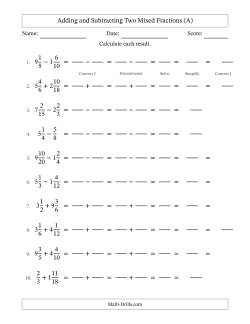
Fraction Circles
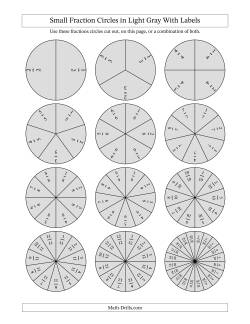
Fraction circle manipulatives are mainly used for comparing fractions, but they can be used for a variety of other purposes such as representing and identifying fractions, adding and subtracting fractions, and as probability spinners. There are a variety of options depending on your purpose. Fraction circles come in small and large versions, labeled and unlabeled versions and in three different color schemes: black and white, color, and light gray. The color scheme matches the fraction strips and use colors that are meant to show good contrast among themselves. Do note that there is a significant prevalence of color-blindness in the population, so don't rely on all students being able to differentiate the colors.
Suggested activity for comparing fractions: Photocopy the black and white version onto an overhead projection slide and another copy onto a piece of paper. Alternatively, you can use two pieces of paper and hold them up to the light for this activity. Use a pencil to represent the first fraction on the paper copy. Use a non-permanent overhead pen to represent the second fraction. Lay the slide over the paper and compare the two circles. You should easily be able to tell which is greater or lesser or if the two fractions are equal. Re-use both sheets by erasing the pencil and washing off the marker.
Adding fractions with fraction circles will involve two copies on paper. Cut out the fraction circles and segments of one copy and leave the other copy intact. To add 1/3 + 1/2, for example, place a 1/3 segment and a 1/2 segment into a circle and hold it over various fractions on the intact copy to see what 1/2 + 1/3 is equivalent to. 5/6 or 10/12 should work.
- Small Fraction Circles Small Fraction Circles in Black and White with Labels Small Fraction Circles in Color with Labels Small Fraction Circles in Light Gray with Labels Small Fraction Circles in Black and White Unlabeled Small Fraction Circles in Color Unlabeled Small Fraction Circles in Light Gray Unlabeled
- Large Fraction Circles Large Fraction Circles in Black and White with Labels Large Fraction Circles in Color with Labels Large Fraction Circles in Light Gray with Labels Large Fraction Circles in Black and White Unlabeled Large Fraction Circles in Color Unlabeled Large Fraction Circles in Light Gray Unlabeled
Fraction Strips
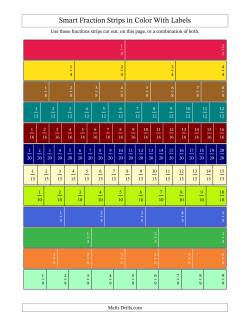
Fractions strips are often used for comparing fractions. Students are able to see quite easily the relationships and equivalence between fractions with different denominators. It can be quite useful for students to have two copies: one copy cut into strips and the other copy kept intact. They can then use the cut-out strips on the intact page to individually compare fractions. For example, they can use the halves strip to see what other fractions are equivalent to one-half. This can also be accomplished with a straight edge such as a ruler without cutting out any strips. Pairs or groups of strips can also be compared side-by-side if they are cut out. Addition and subtraction (etc.) are also possibilities; for example, adding a one-quarter and one-third can be accomplished by shifting the thirds strip so that it starts at the end of one-quarter then finding a strip that matches the end of the one-third mark (7/12 should do it).
Teachers might consider copying the fraction strips onto overhead projection acetates for whole class or group activities. Acetate versions are also useful as a hands-on manipulative for students in conjunction with an uncut page.
The "Smart" Fraction Strips include strips in a more useful order, eliminate the 7ths and 11ths strips as they don't have any equivalents and include 15ths and 16ths. The colors are consistent with the classic versions, so the two sets can be combined.
- Classic Fraction Strips with Labels Classic Fraction Strips in Black and White With Labels Classic Fraction Strips in Color With Labels Classic Fraction Strips in Gray With Labels
- Unlabeled Classic Fraction Strips Classic Fraction Strips in Black and White Unlabeled Classic Fraction Strips in Color Unlabeled Classic Fraction Strips in Gray Unlabeled
- Smart Fraction Strips with Labels Smart Fraction Strips in Black and White With Labels Smart Fraction Strips in Color With Labels Smart Fraction Strips in Gray With Labels
Modeling fractions
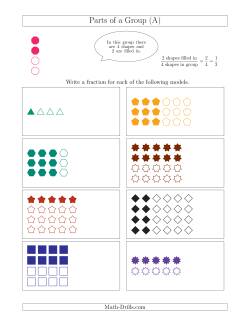
Fractions can represent parts of a group or parts of a whole. In these worksheets, fractions are modeled as parts of a group. Besides using the worksheets in this section, you can also try some more interesting ways of modeling fractions. Healthy snacks can make great models for fractions. Can you cut a cucumber into thirds? A tomato into quarters? Can you make two-thirds of the grapes red and one-third green?
- Modeling Fractions with Groups of Shapes Coloring Groups of Shapes to Represent Fractions Identifying Fractions from Colored Groups of Shapes (Only Simplified Fractions up to Eighths) Identifying Fractions from Colored Groups of Shapes (Halves Only) Identifying Fractions from Colored Groups of Shapes (Halves and Thirds) Identifying Fractions from Colored Groups of Shapes (Halves, Thirds and Fourths) Identifying Fractions from Colored Groups of Shapes (Up to Fifths) Identifying Fractions from Colored Groups of Shapes (Up to Sixths) Identifying Fractions from Colored Groups of Shapes (Up to Eighths) Identifying Fractions from Colored Groups of Shapes (OLD Version; Print Too Light)
- Modeling Fractions with Rectangles Modeling Halves Modeling Thirds Modeling Halves and Thirds Modeling Fourths (Color Version) Modeling Fourths (Grey Version) Coloring Fourths Models Modeling Fifths Coloring Fifths Models Modeling Sixths Coloring Sixths Models
- Modeling Fractions with Circles Modeling Halves, Thirds and Fourths Coloring Halves, Thirds and Fourths Modeling Halves, Thirds, Fourths, and Fifths Coloring Halves, Thirds, Fourths, and Fifths Modeling Halves to Sixths Coloring Halves to Sixths Modeling Halves to Eighths Coloring Halves to Eighths Modeling Halves to Twelfths Coloring Halves to Twelfths
Ratio and Proportion Worksheets
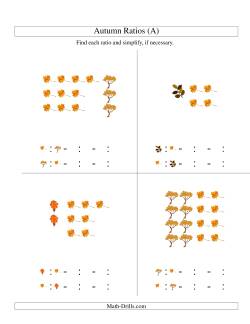
The equivalent fractions models worksheets include only the "baking fractions" in the A versions. To see more difficult and varied fractions, please choose the B to J versions after loading the A version. More picture ratios can be found on holiday and seasonal pages. Try searching for picture ratios to find more.
- Picture Ratios Autumn Trees Part-to-Part Picture Ratios ( Grouped ) Autumn Trees Part-to-Part and Part-to-Whole Picture Ratios ( Grouped )
- Equivalent Fractions Equivalent Fractions With Blanks ( Multiply Right ) ✎ Equivalent Fractions With Blanks ( Divide Left ) ✎ Equivalent Fractions With Blanks ( Multiply Right or Divide Left ) ✎ Equivalent Fractions With Blanks ( Divide Right ) ✎ Equivalent Fractions With Blanks ( Multiply Left ) ✎ Equivalent Fractions With Blanks ( Multiply Left or Divide Right ) ✎ Equivalent Fractions With Blanks ( Multiply or Divide Right ) ✎ Equivalent Fractions With Blanks ( Multiply or Divide Left ) ✎ Equivalent Fractions With Blanks ( Multiply or Divide in Either Direction ) ✎ Are These Fractions Equivalent? (Multiplier 2 to 5) Are These Fractions Equivalent? (Multiplier 5 to 15) Equivalent Fractions Models Equivalent Fractions Models with the Simplified Fraction First Equivalent Fractions Models with the Simplified Fraction Second
- Equivalent Ratios Equivalent Ratios with Blanks Only on Right Equivalent Ratios with Blanks Anywhere Equivalent Ratios with x 's
Comparing and Ordering Fractions
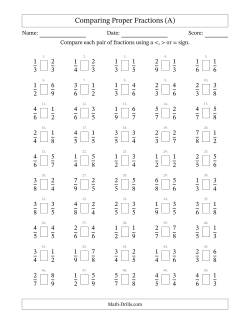
Comparing fractions involves deciding which of two fractions is greater in value or if the two fractions are equal in value. There are generally four methods that can be used for comparing fractions. First is to use common denominators . If both fractions have the same denominator, comparing the fractions simply involves comparing the numerators. Equivalent fractions can be used to convert one or both fractions, so they have common denominators. A second method is to convert both fractions to a decimal and compare the decimal numbers. Visualization is the third method. Using something like fraction strips , two fractions can be compared with a visual tool. The fourth method is to use a cross-multiplication strategy where the numerator of the first fraction is multiplied by the denominator of the second fraction; then the numerator of the second fraction is multiplied by the denominator of the first fraction. The resulting products can be compared to decide which fraction is greater (or if they are equal).
- Comparing Proper Fractions Comparing Proper Fractions to Sixths ✎ Comparing Proper Fractions to Ninths (No Sevenths) ✎ Comparing Proper Fractions to Ninths ✎ Comparing Proper Fractions to Twelfths (No Sevenths; No Elevenths) ✎ Comparing Proper Fractions to Twelfths ✎
The worksheets in this section also include improper fractions. This might make the task of comparing even easier for some questions that involve both a proper and an improper fraction. If students recognize one fraction is greater than one and the other fraction is less than one, the greater fraction will be obvious.
- Comparing Proper and Improper Fractions Comparing Proper and Improper Fractions to Sixths ✎ Comparing Proper and Improper Fractions to Ninths (No Sevenths) ✎ Comparing Proper and Improper Fractions to Ninths ✎ Comparing Proper and Improper Fractions to Twelfths (No Sevenths; No Elevenths) ✎ Comparing Proper and Improper Fractions to Twelfths ✎ Comparing Improper Fractions to Sixths ✎ Comparing Improper Fractions to Ninths (No Sevenths) ✎ Comparing Improper Fractions to Ninths ✎ Comparing Improper Fractions to Twelfths (No Sevenths; No Elevenths) ✎ Comparing Improper Fractions to Twelfths ✎
This section additionally includes mixed fractions. When comparing mixed and improper fractions, it is useful to convert one of the fractions to the other's form either in writing or mentally. Converting to a mixed fraction is probably the better route since the first step is to compare the whole number portions, and if one is greater than the other, the proper fraction portion can be ignored. If the whole number portions are equal, the proper fractions must be compared to see which number is greater.
- Comparing Proper, Improper and Mixed Fractions Comparing Proper, Improper and Mixed Fractions to Sixths ✎ Comparing Proper, Improper and Mixed Fractions to Ninths (No Sevenths) ✎ Comparing Proper, Improper and Mixed Fractions to Ninths ✎ Comparing Proper, Improper and Mixed Fractions to Twelfths (No Sevenths; No Elevenths) ✎ Comparing Proper, Improper and Mixed Fractions to Twelfths ✎
- Comparing Improper and Mixed Fractions Comparing Improper and Mixed Fractions to Sixths ✎ Comparing Improper and Mixed Fractions to Ninths (No Sevenths) ✎ Comparing Improper and Mixed Fractions to Ninths ✎ Comparing Improper and Mixed Fractions to Twelfths (No Sevenths; No Elevenths) ✎ Comparing Improper and Mixed Fractions to Twelfths ✎
- Comparing Mixed Fractions Comparing Mixed Fractions to Sixths ✎ Comparing Mixed Fractions to Ninths (No Sevenths) ✎ Comparing Mixed Fractions to Ninths ✎ Comparing Mixed Fractions to Twelfths (No Sevenths; No Elevenths) ✎ Comparing Mixed Fractions to Twelfths ✎
Many of the same strategies that work for comparing fractions also work for ordering fractions. Using manipulatives such as fraction strips, using number lines, or finding decimal equivalents will all have your student(s) putting fractions in the correct order in no time. We've probably said this before, but make sure that you emphasize that when comparing or ordering fractions, students understand that the whole needs to be the same. Comparing half the population of Canada with a third of the population of the United States won't cut it. Try using some visuals to reinforce this important concept. Even though we've included number lines below, feel free to use your own strategies.
- Ordering Fractions with Easy Denominators on a Number Line Ordering Fractions with Easy Denominators to 10 on a Number Line Ordering Fractions with Easy Denominators to 24 on a Number Line Ordering Fractions with Easy Denominators to 60 on a Number Line Ordering Fractions with Easy Denominators to 100 on a Number Line
- Ordering Fractions with Easy Denominators on a Number Line (Including Negative Fractions) Ordering Fractions with Easy Denominators to 10 + Negatives on a Number Line Ordering Fractions with Easy Denominators to 24 + Negatives on a Number Line Ordering Fractions with Easy Denominators to 60 + Negatives on a Number Line Ordering Fractions with Easy Denominators to 100 + Negatives on a Number Line
- Ordering Fractions with All Denominators on a Number Line Ordering Fractions with All Denominators to 10 on a Number Line Ordering Fractions with All Denominators to 24 on a Number Line Ordering Fractions with All Denominators to 60 on a Number Line Ordering Fractions with All Denominators to 100 on a Number Line
- Ordering Fractions with All Denominators on a Number Line (Including Negative Fractions) Ordering Fractions with All Denominators to 10 + Negatives on a Number Line Ordering Fractions with All Denominators to 24 + Negatives on a Number Line Ordering Fractions with All Denominators to 60 + Negatives on a Number Line Ordering Fractions with All Denominators to 100 + Negatives on a Number Line
The ordering fractions worksheets in this section do not include a number line, to allow for students to use various sorting strategies.
- Ordering Positive Fractions Ordering Positive Fractions with Like Denominators Ordering Positive Fractions with Like Numerators Ordering Positive Fractions with Like Numerators or Denominators Ordering Positive Fractions with Proper Fractions Only Ordering Positive Fractions with Improper Fractions Ordering Positive Fractions with Mixed Fractions Ordering Positive Fractions with Improper and Mixed Fractions
- Ordering Positive and Negative Fractions Ordering Positive and Negative Fractions with Like Denominators Ordering Positive and Negative Fractions with Like Numerators Ordering Positive and Negative Fractions with Like Numerators or Denominators Ordering Positive and Negative Fractions with Proper Fractions Only Ordering Positive and Negative Fractions with Improper Fractions Ordering Positive and Negative Fractions with Mixed Fractions Ordering Positive and Negative Fractions with Improper and Mixed Fractions
Simplifying & Converting Fractions Worksheets
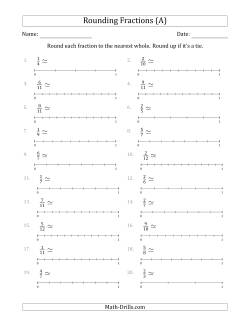
Rounding fractions helps students to understand fractions a little better and can be applied to estimating answers to fractions questions. For example, if one had to estimate 1 4/7 × 6, they could probably say the answer was about 9 since 1 4/7 is about 1 1/2 and 1 1/2 × 6 is 9.
- Rounding Fractions with Helper Lines Rounding Fractions to the Nearest Whole with Helper Lines Rounding Mixed Numbers to the Nearest Whole with Helper Lines Rounding Fractions to the Nearest Half with Helper Lines Rounding Mixed Numbers to the Nearest Half with Helper Lines
- Rounding Fractions Rounding Fractions to the Nearest Whole Rounding Mixed Numbers to the Nearest Whole Rounding Fractions to the Nearest Half Rounding Mixed Numbers to the Nearest Half
Learning how to simplify fractions makes a student's life much easier later on when learning operations with fractions. It also helps them to learn that different-looking fractions can be equivalent. One way of demonstrating this is to divide out two equivalent fractions. For example 3/2 and 6/4 both result in a quotient of 1.5 when divided. By practicing simplifying fractions, students will hopefully recognize unsimplified fractions when they start adding, subtracting, multiplying and dividing with fractions.
- Simplifying Fractions Simplify Fractions (easier) Simplify Fractions (harder) Simplify Improper Fractions (easier) Simplify Improper Fractions (harder)
- Converting Between Improper and Mixed Fractions Converting Mixed Fractions to Improper Fractions Converting Improper Fractions to Mixed Fractions Converting Between (both ways) Mixed and Improper Fractions
- Converting Between Fractions and Decimals Converting Fractions to Terminating Decimals Converting Fractions to Terminating and Repeating Decimals Converting Terminating Decimals to Fractions Converting Terminating and Repeating Decimals to Fractions Converting Fractions to Hundredths
- Converting Between Fractions, Decimals, Percents and Ratios with Terminating Decimals Only Converting Fractions to Decimals, Percents and Part-to- Part Ratios ( Terminating Decimals Only) Converting Fractions to Decimals, Percents and Part-to- Whole Ratios ( Terminating Decimals Only) Converting Decimals to Fractions, Percents and Part-to- Part Ratios ( Terminating Decimals Only) Converting Decimals to Fractions, Percents and Part-to- Whole Ratios ( Terminating Decimals Only) Converting Percents to Fractions, Decimals and Part-to- Part Ratios ( Terminating Decimals Only) Converting Percents to Fractions, Decimals and Part-to- Whole Ratios ( Terminating Decimals Only) Converting Part-to-Part Ratios to Fractions, Decimals and Percents ( Terminating Decimals Only) Converting Part-to-Whole Ratios to Fractions, Decimals and Percents ( Terminating Decimals Only) Converting Various Fractions, Decimals, Percents and Part-to- Part Ratios ( Terminating Decimals Only) Converting Various Fractions, Decimals, Percents and Part-to- Whole Ratios ( Terminating Decimals Only)
- Converting Between Fractions, Decimals, Percents and Ratios with Terminating and Repeating Decimals Converting Fractions to Decimals, Percents and Part-to- Part Ratios Converting Fractions to Decimals, Percents and Part-to- Whole Ratios Converting Decimals to Fractions, Percents and Part-to- Part Ratios Converting Decimals to Fractions, Percents and Part-to- Whole Ratios Converting Percents to Fractions, Decimals and Part-to- Part Ratios Converting Percents to Fractions, Decimals and Part-to- Whole Ratios Converting Part-to-Part Ratios to Fractions, Decimals and Percents Converting Part-to-Whole Ratios to Fractions, Decimals and Percents Converting Various Fractions, Decimals, Percents and Part-to- Part Ratios Converting Various Fractions, Decimals, Percents and Part-to- Whole Ratios Converting Various Fractions, Decimals, Percents and Part-to- Part Ratios with 7ths and 11ths Converting Various Fractions, Decimals, Percents and Part-to- Whole Ratios with 7ths and 11ths
Multiplying Fractions
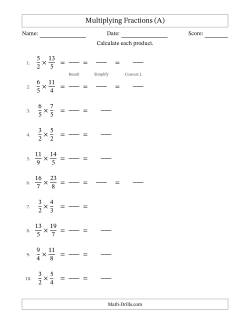
Multiplying fractions is usually less confusing operationally than any other operation and can be less confusing conceptually if approached in the right way. The algorithm for multiplying is simply multiply the numerators then multiply the denominators. The magic word in understanding the multiplication of fractions is, "of." For example what is two-thirds OF six? What is a third OF a half? When you use the word, "of," it gets much easier to visualize fractions multiplication. Example: cut a loaf of bread in half, then cut the half into thirds. One third OF a half loaf of bread is the same as 1/3 x 1/2 and tastes delicious with butter.
- Multiplying Two Proper Fraction Multiplying Two Proper Fractions with No Simplifying (Fillable, Savable, Printable) ✎ Multiplying Two Proper Fractions with All Simplifying (Fillable, Savable, Printable) ✎ ✎ Multiplying Two Proper Fractions with Some Simplifying (Fillable, Savable, Printable) ✎ Multiplying Two Proper Fractions with No Simplifying (Printable Only) Multiplying Two Proper Fractions with All Simplifying (Printable Only) Multiplying Two Proper Fractions with Some Simplifying (Printable Only)
- Multiplying Proper and Improper Fractions Multiplying Proper and Improper Fractions with No Simplifying (Fillable, Savable, Printable) ✎ Multiplying Proper and Improper Fractions with All Simplifying (Fillable, Savable, Printable) ✎ Multiplying Proper and Improper Fractions with Some Simplifying (Fillable, Savable, Printable) ✎ Multiplying Proper and Improper Fractions with No Simplifying (Printable Only) Multiplying Proper and Improper Fractions with All Simplifying (Printable Only) Multiplying Proper and Improper Fractions with Some Simplifying (Printable Only)
- Multiplying Two Improper Fractions Multiplying Two Improper Fractions with No Simplifying (Fillable, Savable, Printable) ✎ Multiplying Two Improper Fractions with All Simplifying (Fillable, Savable, Printable) ✎ Multiplying Two Improper Fractions with Some Simplifying (Fillable, Savable, Printable) ✎ Multiplying Two Improper Fractions with No Simplifying (Printable Only) Multiplying Two Improper Fractions with All Simplifying (Printable Only) Multiplying Two Improper Fractions with Some Simplifying (Printable Only)
- Multiplying Proper and Mixed Fractions Multiplying Proper and Mixed Fractions with No Simplifying (Fillable, Savable, Printable) ✎ Multiplying Proper and Mixed Fractions with All Simplifying (Fillable, Savable, Printable) ✎ Multiplying Proper and Mixed Fractions with Some Simplifying (Fillable, Savable, Printable) ✎ Multiplying Proper and Mixed Fractions with No Simplifying (Printable Only) Multiplying Proper and Mixed Fractions with All Simplifying (Printable Only) Multiplying Proper and Mixed Fractions with Some Simplifying (Printable Only)
- Multiplying Two Mixed Fractions Multiplying Two Mixed Fractions with No Simplifying (Fillable, Savable, Printable) ✎ Multiplying Two Mixed Fractions with All Simplifying (Fillable, Savable, Printable) ✎ Multiplying Two Mixed Fractions with Some Simplifying (Fillable, Savable, Printable) ✎ Multiplying Two Mixed Fractions with No Simplifying (Printable Only) Multiplying Two Mixed Fractions with All Simplifying (Printable Only) Multiplying Two Mixed Fractions with Some Simplifying (Printable Only)
- Multiplying Whole Numbers and Proper Fractions Multiplying Whole Numbers and Proper Fractions with No Simplifying (Fillable, Savable, Printable) ✎ Multiplying Whole Numbers and Proper Fractions with All Simplifying (Fillable, Savable, Printable) ✎ Multiplying Whole Numbers and Proper Fractions with Some Simplifying (Fillable, Savable, Printable) ✎ Multiplying Whole Numbers and Proper Fractions with No Simplifying (Printable Only) Multiplying Whole Numbers and Proper Fractions with All Simplifying (Printable Only) Multiplying Whole Numbers and Proper Fractions with Some Simplifying (Printable Only)
- Multiplying Whole Numbers and Improper Fractions Multiplying Whole Numbers and Improper Fractions with No Simplifying (Fillable, Savable, Printable) ✎ Multiplying Whole Numbers and Improper Fractions with All Simplifying (Fillable, Savable, Printable) ✎ Multiplying Whole Numbers and Improper Fractions with Some Simplifying (Fillable, Savable, Printable) ✎ Multiplying Whole Numbers and Improper Fractions with No Simplifying (Printable Only) Multiplying Whole Numbers and Improper Fractions with All Simplifying (Printable Only) Multiplying Whole Numbers and Improper Fractions with Some Simplifying (Printable Only)
- Multiplying Whole Numbers and Mixed Fractions Multiplying Whole Numbers and Mixed Fractions with No Simplifying (Fillable, Savable, Printable) ✎ Multiplying Whole Numbers and Mixed Fractions with All Simplifying (Fillable, Savable, Printable) ✎ Multiplying Whole Numbers and Mixed Fractions with Some Simplifying (Fillable, Savable, Printable) ✎ Multiplying Whole Numbers and Mixed Fractions with No Simplifying (Printable Only) Multiplying Whole Numbers and Mixed Fractions with All Simplifying (Printable Only) Multiplying Whole Numbers and Mixed Fractions with Some Simplifying (Printable Only)
- Multiplying Proper, Improper and Mixed Fractions Multiplying Proper, Improper and Mixed Fractions with No Simplifying (Fillable, Savable, Printable) ✎ Multiplying Proper, Improper and Mixed Fractions with All Simplifying (Fillable, Savable, Printable) ✎ Multiplying Proper, Improper and Mixed Fractions with Some Simplifying (Fillable, Savable, Printable) ✎ Multiplying Proper, Improper and Mixed Fractions with No Simplifying (Printable Only) Multiplying Proper, Improper and Mixed Fractions with All Simplifying (Printable Only) Multiplying Proper, Improper and Mixed Fractions with Some Simplifying (Printable Only)
- Multiplying 3 Fractions Multiplying 3 Proper Fractions (Fillable, Savable, Printable) ✎ Multiplying 3 Proper and Improper Fractions (Fillable, Savable, Printable) ✎ Multiplying Proper and Improper Fractions and Whole Numbers (3 factors) (Fillable, Savable, Printable) ✎ Multiplying Fractions and Mixed Fractions (3 factors) (Fillable, Savable, Printable) ✎ Multiplying 3 Mixed Fractions (Fillable, Savable, Printable) ✎
Dividing Fractions
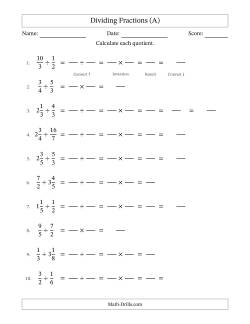
Conceptually, dividing fractions is probably the most difficult of all the operations, but we're going to help you out. The algorithm for dividing fractions is just like multiplying fractions, but you find the inverse of the second fraction or you cross-multiply. This gets you the right answer which is extremely important especially if you're building a bridge. We told you how to conceptualize fraction multiplication, but how does it work with division? Easy! You just need to learn the magic phrase: "How many ____'s are there in ______? For example, in the question 6 ÷ 1/2, you would ask, "How many halves are there in 6?" It becomes a little more difficult when both numbers are fractions, but it isn't a giant leap to figure it out. 1/2 ÷ 1/4 is a fairly easy example, especially if you think in terms of U.S. or Canadian coins. How many quarters are there in a half dollar?
- Dividing Two Proper Fractions Dividing Two Proper Fractions with No Simplifying (Fillable, Savable, Printable) ✎ Dividing Two Proper Fractions with All Simplifying (Fillable, Savable, Printable) ✎ Dividing Two Proper Fractions with Some Simplifying (Fillable, Savable, Printable) ✎ Dividing Two Proper Fractions with No Simplifying (Printable Only) Dividing Two Proper Fractions with All Simplifying (Printable Only) Dividing Two Proper Fractions with Some Simplifying (Printable Only)
- Dividing Proper and Improper Fractions Dividing Proper and Improper Fractions with No Simplifying (Fillable, Savable, Printable) ✎ Dividing Proper and Improper Fractions with All Simplifying (Fillable, Savable, Printable) ✎ Dividing Proper and Improper Fractions with Some Simplifying (Fillable, Savable, Printable) ✎ Dividing Proper and Improper Fractions with No Simplifying (Printable Only) Dividing Proper and Improper Fractions with All Simplifying (Printable Only) Dividing Proper and Improper Fractions with Some Simplifying (Printable Only)
- Dividing Two Improper Fractions Dividing Two Improper Fractions with No Simplifying (Fillable, Savable, Printable) ✎ Dividing Two Improper Fractions with All Simplifying (Fillable, Savable, Printable) ✎ Dividing Two Improper Fractions with Some Simplifying (Fillable, Savable, Printable) ✎ Dividing Two Improper Fractions with No Simplifying (Printable Only) Dividing Two Improper Fractions with All Simplifying (Printable Only) Dividing Two Improper Fractions with Some Simplifying (Printable Only)
- Dividing Proper and Mixed Fractions Dividing Proper and Mixed Fractions with No Simplifying (Fillable, Savable, Printable) ✎ Dividing Proper and Mixed Fractions with All Simplifying (Fillable, Savable, Printable) ✎ Dividing Proper and Mixed Fractions with Some Simplifying (Fillable, Savable, Printable) ✎ Dividing Proper and Mixed Fractions with No Simplifying (Printable Only) Dividing Proper and Mixed Fractions with All Simplifying (Printable Only) Dividing Proper and Mixed Fractions with Some Simplifying (Printable Only)
- Dividing Two Mixed Fractions Dividing Two Mixed Fractions with No Simplifying (Fillable, Savable, Printable) ✎ Dividing Two Mixed Fractions with All Simplifying (Fillable, Savable, Printable) ✎ Dividing Two Mixed Fractions with Some Simplifying (Fillable, Savable, Printable) ✎ Dividing Two Mixed Fractions with No Simplifying (Printable Only) Dividing Two Mixed Fractions with All Simplifying (Printable Only) Dividing Two Mixed Fractions with Some Simplifying (Printable Only)
- Dividing Whole Numbers and Proper Fractions Dividing Whole Numbers and Proper Fractions with No Simplifying (Fillable, Savable, Printable) ✎ Dividing Whole Numbers and Proper Fractions with All Simplifying (Fillable, Savable, Printable) ✎ Dividing Whole Numbers and Proper Fractions with Some Simplifying (Fillable, Savable, Printable) ✎ Dividing Whole Numbers and Proper Fractions with No Simplifying (Printable Only) Dividing Whole Numbers and Proper Fractions with All Simplifying (Printable Only) Dividing Whole Numbers and Proper Fractions with Some Simplifying (Printable Only)
- Dividing Whole Numbers and Improper Fractions Dividing Whole Numbers and Improper Fractions with No Simplifying (Fillable, Savable, Printable) ✎ Dividing Whole Numbers and Improper Fractions with All Simplifying (Fillable, Savable, Printable) ✎ Dividing Whole Numbers and Improper Fractions with Some Simplifying (Fillable, Savable, Printable) ✎ Dividing Whole Numbers and Improper Fractions with No Simplifying (Printable Only) Dividing Whole Numbers and Improper Fractions with All Simplifying (Printable Only) Dividing Whole Numbers and Improper Fractions with Some Simplifying (Printable Only)
- Dividing Whole Numbers and Mixed Fractions Dividing Whole Numbers and Mixed Fractions with No Simplifying (Fillable, Savable, Printable) ✎ Dividing Whole Numbers and Mixed Fractions with All Simplifying (Fillable, Savable, Printable) ✎ Dividing Whole Numbers and Mixed Fractions with Some Simplifying (Fillable, Savable, Printable) ✎ Dividing Whole Numbers and Mixed Fractions with No Simplifying (Printable Only) Dividing Whole Numbers and Mixed Fractions with All Simplifying (Printable Only) Dividing Whole Numbers and Mixed Fractions with Some Simplifying (Printable Only)
- Dividing Proper, Improper and Mixed Fractions Dividing Proper, Improper and Mixed Fractions with No Simplifying (Fillable, Savable, Printable) ✎ Dividing Proper, Improper and Mixed Fractions with All Simplifying (Fillable, Savable, Printable) ✎ Dividing Proper, Improper and Mixed Fractions with Some Simplifying (Fillable, Savable, Printable) ✎ Dividing Proper, Improper and Mixed Fractions with No Simplifying (Printable Only) Dividing Proper, Improper and Mixed Fractions with All Simplifying (Printable Only) Dividing Proper, Improper and Mixed Fractions with Some Simplifying (Printable Only)
- Dividing 3 Fractions Dividing 3 Fractions Dividing 3 Fractions (Some Whole Numbers) Dividing 3 Fractions (Some Mixed) Dividing 3 Mixed Fractions
Multiplying and Dividing Fractions
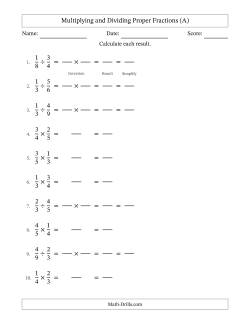
This section includes worksheets with both multiplication and division mixed on each worksheet. Students will have to pay attention to the signs.
- Multiplying and Dividing Two Proper Fractions Multiplying and Dividing Two Proper Fractions with No Simplifying (Fillable, Savable, Printable) ✎ Multiplying and Dividing Two Proper Fractions with All Simplifying (Fillable, Savable, Printable) ✎ Multiplying and Dividing Two Proper Fractions with Some Simplifying (Fillable, Savable, Printable) ✎ Multiplying and Dividing Two Proper Fractions with No Simplifying (Printable Only) Multiplying and Dividing Two Proper Fractions with All Simplifying (Printable Only) Multiplying and Dividing Two Proper Fractions with Some Simplifying (Printable Only)
- Multiplying and Dividing Proper and Improper Fractions Multiplying and Dividing Proper and Improper Fractions with No Simplifying (Fillable, Savable, Printable) ✎ Multiplying and Dividing Proper and Improper Fractions with All Simplifying (Fillable, Savable, Printable) ✎ Multiplying and Dividing Proper and Improper Fractions with Some Simplifying (Fillable, Savable, Printable) ✎ Multiplying and Dividing Proper and Improper Fractions with No Simplifying (Printable Only) Multiplying and Dividing Proper and Improper Fractions with All Simplifying (Printable Only) Multiplying and Dividing Proper and Improper Fractions with Some Simplifying (Printable Only)
- Multiplying and Dividing Two Improper Fractions Multiplying and Dividing Two Improper Fractions with No Simplifying (Fillable, Savable, Printable) ✎ Multiplying and Dividing Two Improper Fractions with All Simplifying (Fillable, Savable, Printable) ✎ Multiplying and Dividing Two Improper Fractions (Fillable, Savable, Printable) ✎ Multiplying and Dividing Two Improper Fractions with No Simplifying (Printable Only) Multiplying and Dividing Two Improper Fractions with All Simplifying (Printable Only) Multiplying and Dividing Two Improper Fractions (Printable Only)
- Multiplying and Dividing Proper and Mixed Fractions Multiplying and Dividing Proper and Mixed Fractions with No Simplifying (Fillable, Savable, Printable) ✎ Multiplying and Dividing Proper and Mixed Fractions with All Simplifying (Fillable, Savable, Printable) ✎ Multiplying and Dividing Proper and Mixed Fractions with Some Simplifying (Fillable, Savable, Printable) ✎ Multiplying and Dividing Proper and Mixed Fractions with No Simplifying (Printable Only) Multiplying and Dividing Proper and Mixed Fractions with All Simplifying (Printable Only) Multiplying and Dividing Proper and Mixed Fractions with Some Simplifying (Printable Only)
- Multiplying and Dividing Two Mixed Fractions Multiplying and Dividing Two Mixed Fractions with No Simplifying (Fillable, Savable, Printable) ✎ Multiplying and Dividing Two Mixed Fractions with All Simplifying (Fillable, Savable, Printable) ✎ Multiplying and Dividing Two Mixed Fractions with Some Simplifying (Fillable, Savable, Printable) ✎ Multiplying and Dividing Two Mixed Fractions with No Simplifying (Printable Only) Multiplying and Dividing Two Mixed Fractions with All Simplifying (Printable Only) Multiplying and Dividing Two Mixed Fractions with Some Simplifying (Printable Only)
- Multiplying and Dividing Whole Numbers and Proper Fractions Fractions Multiplying and Dividing Whole Numbers and Proper Fractions with No Simplifying (Fillable, Savable, Printable) ✎ Multiplying and Dividing Whole Numbers and Proper Fractions with All Simplifying (Fillable, Savable, Printable) ✎ Multiplying and Dividing Whole Numbers and Proper Fractions with Some Simplifying (Fillable, Savable, Printable) ✎ Multiplying and Dividing Whole Numbers and Proper Fractions with No Simplifying (Printable Only) Multiplying and Dividing Whole Numbers and Proper Fractions with All Simplifying (Printable Only) Multiplying and Dividing Whole Numbers and Proper Fractions with Some Simplifying (Printable Only)
- Multiplying and Dividing Whole Numbers and Improper Fractions Multiplying and Dividing Whole Numbers and Improper Fractions with No Simplifying (Fillable, Savable, Printable) ✎ Multiplying and Dividing Whole Numbers and Improper Fractions with All Simplifying (Fillable, Savable, Printable) ✎ Multiplying and Dividing Whole Numbers and Improper Fractions with Some Simplifying (Fillable, Savable, Printable) ✎ Multiplying and Dividing Whole Numbers and Improper Fractions with No Simplifying (Printable Only) Multiplying and Dividing Whole Numbers and Improper Fractions with All Simplifying (Printable Only) Multiplying and Dividing Whole Numbers and Improper Fractions with Some Simplifying (Printable Only)
- Multiplying and Dividing Whole Numbers and Mixed Fractions Multiplying and Dividing Whole Numbers and Mixed Fractions with No Simplifying (Fillable, Savable, Printable) ✎ Multiplying and Dividing Whole Numbers and Mixed Fractions with All Simplifying (Fillable, Savable, Printable) ✎ Multiplying and Dividing Whole Numbers and Mixed Fractions with Some Simplifying (Fillable, Savable, Printable) ✎ Multiplying and Dividing Whole Numbers and Mixed Fractions with No Simplifying (Printable Only) Multiplying and Dividing Whole Numbers and Mixed Fractions with All Simplifying (Printable Only) Multiplying and Dividing Whole Numbers and Mixed Fractions with Some Simplifying (Printable Only)
- Multiplying and Dividing Proper, Improper and Mixed Fractions Multiplying and Dividing Proper, Improper and Mixed Fractions with No Simplifying (Fillable, Savable, Printable) ✎ Multiplying and Dividing Proper, Improper and Mixed Fractions with All Simplifying (Fillable, Savable, Printable) ✎ Multiplying and Dividing Proper, Improper and Mixed Fractions with Some Simplifying (Fillable, Savable, Printable) ✎ Multiplying and Dividing Proper, Improper and Mixed Fractions with No Simplifying (Printable Only) Multiplying and Dividing Proper, Improper and Mixed Fractions with All Simplifying (Printable Only) Multiplying and Dividing Proper, Improper and Mixed Fractions with Some Simplifying (Printable Only)
- Multiplying and Dividing 3 Fractions Multiplying/Dividing Fractions (three factors) Multiplying/Dividing Mixed Fractions (3 factors)
Adding Fractions
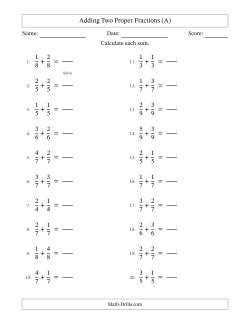
Adding fractions requires the annoying common denominator. Make it easy on your students by first teaching the concepts of equivalent fractions and least common multiples. Once students are familiar with those two concepts, the idea of finding fractions with common denominators for adding becomes that much easier. Spending time on modeling fractions will also help students to understand fractions addition. Relating fractions to familiar examples will certainly help. For example, if you add a 1/2 banana and a 1/2 banana, you get a whole banana. What happens if you add a 1/2 banana and 3/4 of another banana?
- Adding Two Proper Fractions with Equal Denominators and Proper Fraction Results Adding Two Proper Fractions with Equal Denominators, Proper Fractions Results, and No Simplifying (Fillable, Savable, Printable) ✎ Adding Two Proper Fractions with Equal Denominators, Proper Fractions Results, and All Simplifying (Fillable, Savable, Printable) ✎ Adding Two Proper Fractions with Equal Denominators, Proper Fractions Results, and Some Simplifying (Fillable, Savable, Printable) ✎ Adding Two Proper Fractions with Equal Denominators, Proper Fractions Result, and No Simplifying (Printable Only) Adding Two Proper Fractions with Equal Denominators, Proper Fractions Result, and All Simplifying (Printable Only) Adding Two Proper Fractions with Equal Denominators, Proper Fractions Result, and Some Simplifying (Printable Only)
- Adding Two Proper Fractions with Equal Denominators and Mixed Fraction Results Adding Two Proper Fractions with Equal Denominators, Mixed Fractions Results, and No Simplifying (Fillable, Savable, Printable) ✎ Adding Two Proper Fractions with Equal Denominators, Mixed Fractions Results, and All Simplifying (Fillable, Savable, Printable) ✎ Adding Two Proper Fractions with Equal Denominators, Mixed Fractions Results, and Some Simplifying (Fillable, Savable, Printable) ✎ Adding Two Proper Fractions with Equal Denominators, Mixed Fractions Result, and No Simplifying (Printable Only) Adding Two Proper Fractions with Equal Denominators, Mixed Fractions Result, and All Simplifying (Printable Only) Adding Two Proper Fractions with Equal Denominators, Mixed Fractions Result, and Some Simplifying (Printable Only)
- Adding Two Proper Fractions with Similar Denominators and Proper Fraction Results Adding Two Proper Fractions with Similar Denominators, Proper Fractions Results, and No Simplifying (Fillable, Savable, Printable) ✎ Adding Two Proper Fractions with Similar Denominators, Proper Fractions Results, and No Simplifying (Fillable, Savable, Printable) ✎ Adding Two Proper Fractions with Similar Denominators, Proper Fractions Results, and Some Simplifying (Fillable, Savable, Printable) ✎ Adding Two Proper Fractions with Similar Denominators, Proper Fractions Result, and No Simplifying (Printable Only) Adding Two Proper Fractions with Similar Denominators, Proper Fractions Result, and All Simplifying (Printable Only) Adding Two Proper Fractions with Similar Denominators, Proper Fractions Result, and Some Simplifying (Printable Only)
- Adding Two Proper Fractions with Similar Denominators and Mixed Fraction Results Adding Two Proper Fractions with Similar Denominators, Mixed Fractions Results, and No Simplifying (Fillable, Savable, Printable) ✎ Adding Two Proper Fractions with Similar Denominators, Mixed Fractions Results, and All Simplifying (Fillable, Savable, Printable) ✎ Adding Two Proper Fractions with Similar Denominators, Mixed Fractions Results, and Some Simplifying (Fillable, Savable, Printable) ✎ Adding Two Proper Fractions with Similar Denominators, Mixed Fractions Result, and No Simplifying (Printable Only) Adding Two Proper Fractions with Similar Denominators, Mixed Fractions Result, and All Simplifying (Printable Only) Adding Two Proper Fractions with Similar Denominators, Mixed Fractions Result, and Some Simplifying (Printable Only)
- Adding Two Proper Fractions with Unlike Denominators and Proper Fraction Results Adding Two Proper Fractions with Unlike Denominators, Proper Fractions Results, and No Simplifying (Fillable, Savable, Printable) ✎ Adding Two Proper Fractions with Unlike Denominators, Proper Fractions Results, and All Simplifying (Fillable, Savable, Printable) ✎ Adding Two Proper Fractions with Unlike Denominators, Proper Fractions Results, and Some Simplifying (Fillable, Savable, Printable) ✎ Adding Two Proper Fractions with Unlike Denominators, Proper Fractions Result, and No Simplifying (Printable Only) Adding Two Proper Fractions with Unlike Denominators, Proper Fractions Result, and All Simplifying (Printable Only) Adding Two Proper Fractions with Unlike Denominators, Proper Fractions Result, and Some Simplifying (Printable Only)
- Adding Two Proper Fractions with Unlike Denominators and Mixed Fraction Results Adding Two Proper Fractions with Unlike Denominators, Mixed Fractions Results, and No Simplifying (Fillable, Savable, Printable) ✎ Adding Two Proper Fractions with Unlike Denominators, Mixed Fractions Results, and All Simplifying (Fillable, Savable, Printable) ✎ Adding Two Proper Fractions with Unlike Denominators, Mixed Fractions Results, and Some Simplifying (Fillable, Savable, Printable) ✎ Adding Two Proper Fractions with Unlike Denominators, Mixed Fractions Result, and No Simplifying (Printable Only) Adding Two Proper Fractions with Unlike Denominators, Mixed Fractions Result, and All Simplifying (Printable Only) Adding Two Proper Fractions with Unlike Denominators, Mixed Fractions Result, and Some Simplifying (Printable Only)
- Adding Proper and Improper Fractions with Equal Denominators Adding Proper and Improper Fractions with Equal Denominators and No Simplifying (Fillable, Savable, Printable) ✎ Adding Proper and Improper Fractions with Equal Denominators and All Simplifying (Fillable, Savable, Printable) ✎ Adding Proper and Improper Fractions with Equal Denominators and Some Simplifying (Fillable, Savable, Printable) ✎ Adding Proper and Improper Fractions with Equal Denominators and No Simplifying (Printable Only) Adding Proper and Improper Fractions with Equal Denominators and All Simplifying (Printable Only) Adding Proper and Improper Fractions with Equal Denominators and Some Simplifying (Printable Only)
- Adding Proper and Improper Fractions with Similar Denominators Adding Proper and Improper Fractions with Similar Denominators and No Simplifying (Fillable, Savable, Printable) ✎ Adding Proper and Improper Fractions with Similar Denominators and All Simplifying (Fillable, Savable, Printable) ✎ Adding Proper and Improper Fractions with Similar Denominators and Some Simplifying (Fillable, Savable, Printable) ✎ Adding Proper and Improper Fractions with Similar Denominators and No Simplifying (Printable Only) Adding Proper and Improper Fractions with Similar Denominators and All Simplifying (Printable Only) Adding Proper and Improper Fractions with Similar Denominators and Some Simplifying (Printable Only)
- Adding Proper and Improper Fractions with Unlike Denominators Adding Proper and Improper Fractions with Unlike Denominators and No Simplifying (Fillable, Savable, Printable) ✎ Adding Proper and Improper Fractions with Unlike Denominators and All Simplifying (Fillable, Savable, Printable) ✎ Adding Proper and Improper Fractions with Unlike Denominators and Some Simplifying (Fillable, Savable, Printable) ✎ Adding Proper and Improper Fractions with Unlike Denominators and No Simplifying (Printable Only) Adding Proper and Improper Fractions with Unlike Denominators and All Simplifying (Printable Only) Adding Proper and Improper Fractions with Unlike Denominators and Some Simplifying (Printable Only)
A common strategy to use when adding mixed fractions is to convert the mixed fractions to improper fractions, complete the addition, then switch back. Another strategy which requires a little less brainpower is to look at the whole numbers and fractions separately. Add the whole numbers first. Add the fractions second. If the resulting fraction is improper, then it needs to be converted to a mixed number. The whole number portion can be added to the original whole number portion.
- Adding Two Mixed Fractions with Equal Denominators Adding Two Mixed Fractions with Equal Denominators and No Simplifying (Fillable, Savable, Printable) ✎ Adding Two Mixed Fractions with Equal Denominators and All Simplifying (Fillable, Savable, Printable) ✎ Adding Two Mixed Fractions with Equal Denominators and Some Simplifying (Fillable, Savable, Printable) ✎ Adding Two Mixed Fractions with Equal Denominators and No Simplifying (Printable Only) Adding Two Mixed Fractions with Equal Denominators and All Simplifying (Printable Only) Adding Two Mixed Fractions with Equal Denominators and Some Simplifying (Printable Only)
- Adding Two Mixed Fractions with Similar Denominators Adding Two Mixed Fractions with Similar Denominators and No Simplifying (Fillable, Savable, Printable) ✎ Adding Two Mixed Fractions with Similar Denominators and All Simplifying (Fillable, Savable, Printable) ✎ Adding Two Mixed Fractions with Similar Denominators and Some Simplifying Adding Two Mixed Fractions with Similar Denominators and No Simplifying (Printable Only) Adding Two Mixed Fractions with Similar Denominators and All Simplifying (Printable Only) Adding Two Mixed Fractions with Similar Denominators and Some Simplifying (Printable Only)
- Adding Two Mixed Fractions with Unlike Denominators Adding Two Mixed Fractions with Unlike Denominators and No Simplifying (Fillable, Savable, Printable) ✎ Adding Two Mixed Fractions with Unlike Denominators and All Simplifying (Fillable, Savable, Printable) ✎ Adding Two Mixed Fractions with Unlike Denominators and Some Simplifying (Fillable, Savable, Printable) ✎ Adding Two Mixed Fractions with Unlike Denominators and No Simplifying (Printable Only) Adding Two Mixed Fractions with Unlike Denominators and All Simplifying (Printable Only) Adding Two Mixed Fractions with Unlike Denominators and Some Simplifying (Printable Only)
Subtracting Fractions
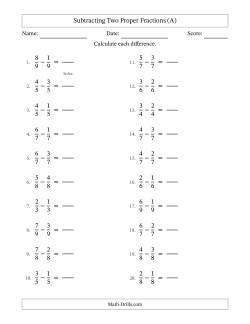
There isn't a lot of difference between adding and subtracting fractions. Both require a common denominator which requires some prerequisite knowledge. The only difference is the second and subsequent numerators are subtracted from the first one. There is a danger that you might end up with a negative number when subtracting fractions, so students might need to learn what it means in that case. When it comes to any concept in fractions, it is always a good idea to relate it to a familiar or easy-to-understand situation. For example, 7/8 - 3/4 = 1/8 could be given meaning in the context of a race. The first runner was 7/8 around the track when the second runner was 3/4 around the track. How far ahead was the first runner? (1/8 of the track).
- Subtracting Two Proper Fractions with Equal Denominators and Proper Fraction Results Subtracting Two Proper Fractions with Equal Denominators, Proper Fractions Results, and No Simplifying (Fillable, Savable, Printable) ✎ Subtracting Two Proper Fractions with Equal Denominators, Proper Fractions Results, and All Simplifying (Fillable, Savable, Printable) ✎ Subtracting Two Proper Fractions with Equal Denominators, Proper Fractions Results, and Some Simplifying (Fillable, Savable, Printable) ✎ Subtracting Two Proper Fractions with Equal Denominators, Proper Fractions Results, and No Simplifying (Printable Only) Subtracting Two Proper Fractions with Equal Denominators, Proper Fractions Results, and All Simplifying (Printable Only) Subtracting Two Proper Fractions with Equal Denominators, Proper Fractions Results, and Some Simplifying (Printable Only)
- Subtracting Two Proper Fractions with Similar Denominators and Proper Fraction Results Subtracting Two Proper Fractions with Similar Denominators, Proper Fractions Results, and No Simplifying (Fillable, Savable, Printable) ✎ Subtracting Two Proper Fractions with Similar Denominators, Proper Fractions Results, and All Simplifying (Fillable, Savable, Printable) ✎ Subtracting Two Proper Fractions with Similar Denominators, Proper Fractions Results, and Some Simplifying (Fillable, Savable, Printable) ✎ Subtracting Two Proper Fractions with Similar Denominators, Proper Fractions Results, and No Simplifying (Printable Only) Subtracting Two Proper Fractions with Similar Denominators, Proper Fractions Results, and All Simplifying (Printable Only) Subtracting Two Proper Fractions with Similar Denominators, Proper Fractions Results, and Some Simplifying (Printable Only)
- Subtracting Two Proper Fractions with Unlike Denominators and Proper Fraction Results Subtracting Two Proper Fractions with Unlike Denominators, Proper Fractions Results, and No Simplifying (Fillable, Savable, Printable) ✎ Subtracting Two Proper Fractions with Unlike Denominators, Proper Fractions Results, and All Simplifying (Fillable, Savable, Printable) ✎ Subtracting Two Proper Fractions with Unlike Denominators, Proper Fractions Results, and Some Simplifying (Fillable, Savable, Printable) ✎ Subtracting Two Proper Fractions with Unlike Denominators, Proper Fractions Results, and No Simplifying (Printable Only) Subtracting Two Proper Fractions with Unlike Denominators, Proper Fractions Results, and All Simplifying (Printable Only) Subtracting Two Proper Fractions with Unlike Denominators, Proper Fractions Results, and Some Simplifying (Printable Only)
- Subtracting Proper and Improper Fractions with Equal Denominators and Proper Fraction Results Subtracting Proper and Improper Fractions with Equal Denominators, Proper Fractions Results, and No Simplifying (Fillable, Savable, Printable) ✎ Subtracting Proper and Improper Fractions with Equal Denominators, Proper Fractions Results, and All Simplifying (Fillable, Savable, Printable) ✎ Subtracting Proper and Improper Fractions with Equal Denominators, Proper Fractions Results, and Some Simplifying (Fillable, Savable, Printable) ✎ Subtracting Proper and Improper Fractions with Equal Denominators, Proper Fractions Results, and No Simplifying (Printable Only) Subtracting Proper and Improper Fractions with Equal Denominators, Proper Fractions Results, and All Simplifying (Printable Only) Subtracting Proper and Improper Fractions with Equal Denominators, Proper Fractions Results, and Some Simplifying (Printable Only)
- Subtracting Proper and Improper Fractions with Similar Denominators and Proper Fraction Results Subtracting Proper and Improper Fractions with Similar Denominators, Proper Fractions Results, and No Simplifying (Fillable, Savable, Printable) ✎ Subtracting Proper and Improper Fractions with Similar Denominators, Proper Fractions Results, and All Simplifying (Fillable, Savable, Printable) ✎ Subtracting Proper and Improper Fractions with Similar Denominators, Proper Fractions Results, and Some Simplifying (Fillable, Savable, Printable) ✎ Subtracting Proper and Improper Fractions with Similar Denominators, Proper Fractions Results, and No Simplifying (Printable Only) Subtracting Proper and Improper Fractions with Similar Denominators, Proper Fractions Results, and All Simplifying (Printable Only) Subtracting Proper and Improper Fractions with Similar Denominators, Proper Fractions Results, and Some Simplifying (Printable Only)
- Subtracting Proper and Improper Fractions with Unlike Denominators and Proper Fraction Results Subtracting Proper and Improper Fractions with Unlike Denominators, Proper Fractions Results, and No Simplifying (Fillable, Savable, Printable) ✎ Subtracting Proper and Improper Fractions with Unlike Denominators, Proper Fractions Results, and All Simplifying (Fillable, Savable, Printable) ✎ Subtracting Proper and Improper Fractions with Unlike Denominators, Proper Fractions Results, and Some Simplifying (Fillable, Savable, Printable) ✎ Subtracting Proper and Improper Fractions with Unlike Denominators, Proper Fractions Results, and No Simplifying (Printable Only) Subtracting Proper and Improper Fractions with Unlike Denominators, Proper Fractions Results, and All Simplifying (Printable Only) Subtracting Proper and Improper Fractions with Unlike Denominators, Proper Fractions Results, and Some Simplifying (Printable Only)
- Subtracting Proper and Improper Fractions with Equal Denominators and Mixed Fraction Results Subtracting Proper and Improper Fractions with Equal Denominators, Mixed Fractions Results, and No Simplifying (Fillable, Savable, Printable) ✎ Subtracting Proper and Improper Fractions with Equal Denominators, Mixed Fractions Results, and All Simplifying (Fillable, Savable, Printable) ✎ Subtracting Proper and Improper Fractions with Equal Denominators, Mixed Fractions Results, and Some Simplifying (Fillable, Savable, Printable) ✎ Subtracting Proper and Improper Fractions with Equal Denominators, Mixed Fractions Results, and No Simplifying (Printable Only) Subtracting Proper and Improper Fractions with Equal Denominators, Mixed Fractions Results, and All Simplifying (Printable Only) Subtracting Proper and Improper Fractions with Equal Denominators, Mixed Fractions Results, and Some Simplifying (Printable Only)
- Subtracting Proper and Improper Fractions with Similar Denominators and Mixed Fraction Results Subtracting Proper and Improper Fractions with Similar Denominators, Mixed Fractions Results, and No Simplifying (Fillable, Savable, Printable) ✎ Subtracting Proper and Improper Fractions with Similar Denominators, Mixed Fractions Results, and All Simplifying (Fillable, Savable, Printable) ✎ Subtracting Proper and Improper Fractions with Similar Denominators, Mixed Fractions Results, and Some Simplifying (Fillable, Savable, Printable) ✎ Subtracting Proper and Improper Fractions with Similar Denominators, Mixed Fractions Results, and No Simplifying (Printable Only) Subtracting Proper and Improper Fractions with Similar Denominators, Mixed Fractions Results, and All Simplifying (Printable Only) Subtracting Proper and Improper Fractions with Similar Denominators, Mixed Fractions Results, and Some Simplifying (Printable Only)
- Subtracting Proper and Improper Fractions with Unlike Denominators and Mixed Fraction Results Subtracting Proper and Improper Fractions with Unlike Denominators, Mixed Fractions Results, and No Simplifying (Fillable, Savable, Printable) ✎ Subtracting Proper and Improper Fractions with Unlike Denominators, Mixed Fractions Results, and All Simplifying (Fillable, Savable, Printable) ✎ Subtracting Proper and Improper Fractions with Unlike Denominators, Mixed Fractions Results, and Some Simplifying (Fillable, Savable, Printable) ✎ Subtracting Proper and Improper Fractions with Unlike Denominators, Mixed Fractions Results, and No Simplifying (Printable Only) Subtracting Proper and Improper Fractions with Unlike Denominators, Mixed Fractions Results, and All Simplifying (Printable Only) Subtracting Proper and Improper Fractions with Unlike Denominators, Mixed Fractions Results, and Some Simplifying (Printable Only)
- Subtracting Mixed Fractions with Equal Denominators Subtracting Mixed Fractions with Equal Denominators, and No Simplifying (Fillable, Savable, Printable) ✎ Subtracting Mixed Fractions with Equal Denominators, and All Simplifying (Fillable, Savable, Printable) ✎ Subtracting Mixed Fractions with Equal Denominators, and Some Simplifying (Fillable, Savable, Printable) ✎ Subtracting Mixed Fractions with Equal Denominators, and No Simplifying (Printable Only) Subtracting Mixed Fractions with Equal Denominators, and All Simplifying (Printable Only) Subtracting Mixed Fractions with Equal Denominators, and Some Simplifying (Printable Only)
- Subtracting Mixed Fractions with Similar Denominators Subtracting Mixed Fractions with Similar Denominators, and No Simplifying (Fillable, Savable, Printable) ✎ Subtracting Mixed Fractions with Similar Denominators, and All Simplifying (Fillable, Savable, Printable) ✎ Subtracting Mixed Fractions with Similar Denominators, and Some Simplifying (Fillable, Savable, Printable) ✎ Subtracting Mixed Fractions with Similar Denominators, and No Simplifying (Printable Only) Subtracting Mixed Fractions with Similar Denominators, and All Simplifying (Printable Only) Subtracting Mixed Fractions with Similar Denominators, and Some Simplifying (Printable Only)
- Subtracting Mixed Fractions with Unlike Denominators Subtracting Mixed Fractions with Unlike Denominators, and No Simplifying (Fillable, Savable, Printable) ✎ Subtracting Mixed Fractions with Unlike Denominators, and All Simplifying (Fillable, Savable, Printable) ✎ Subtracting Mixed Fractions with Unlike Denominators, and Some Simplifying (Fillable, Savable, Printable) ✎ Subtracting Mixed Fractions with Unlike Denominators, and No Simplifying (Printable Only) Subtracting Mixed Fractions with Unlike Denominators, and All Simplifying (Printable Only) Subtracting Mixed Fractions with Unlike Denominators, and Some Simplifying (Printable Only)
Adding and Subtracting Fractions
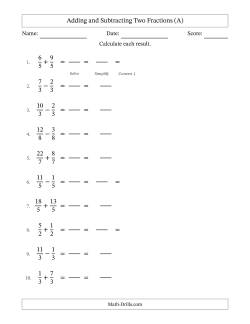
Mixing up the signs on operations with fractions worksheets makes students pay more attention to what they are doing and allows for a good test of their skills in more than one operation.
- Adding and Subtracting Proper and Improper Fractions Adding and Subtracting Proper and Improper Fractions with Equal Denominators and Some Simplifying (Fillable, Savable, Printable) ✎ Adding and Subtracting Proper and Improper Fractions with Similar Denominators and Some Simplifying (Fillable, Savable, Printable) ✎ Adding and Subtracting Proper and Improper Fractions with Unlike Denominators and Some Simplifying (Fillable, Savable, Printable) ✎ Adding and Subtracting Proper and Improper Fractions with Equal Denominators and Some Simplifying (Printable Only) Adding and Subtracting Proper and Improper Fractions with Similar Denominators and Some Simplifying (Printable Only) Adding and Subtracting Proper and Improper Fractions with Unlike Denominators and Some Simplifying (Printable Only)
- Adding and Subtracting Mixed Fractions Adding and Subtracting Mixed Fractions with Equal Denominators and Some Simplifying (Fillable, Savable, Printable) ✎ Adding and Subtracting Mixed Fractions with Similar Denominators and Some Simplifying (Fillable, Savable, Printable) ✎ Adding and Subtracting Mixed Fractions with Unlike Denominators and Some Simplifying (Fillable, Savable, Printable) ✎ Adding and Subtracting Mixed Fractions with Equal Denominators and Some Simplifying (Printable Only) Adding and Subtracting Mixed Fractions with Similar Denominators and Some Simplifying (Printable Only) Adding and Subtracting Mixed Fractions with Unlike Denominators and Some Simplifying (Printable Only) Adding/Subtracting Three Fractions/Mixed Fractions
All Operations Fractions Worksheets
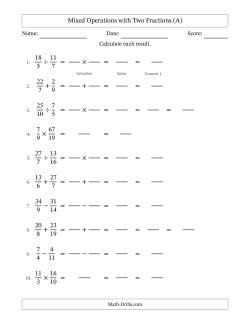
- All Operations with Two Proper Fractions with Equal Denominators and Proper Fraction Results All Operations with Two Proper Fractions with Equal Denominators, Proper Fractions Results and No Simplifying (Fillable, Savable, Printable) ✎ All Operations with Two Proper Fractions with Equal Denominators, Proper Fractions Results and All Simplifying (Fillable, Savable, Printable) ✎ All Operations with Two Proper Fractions with Equal Denominators, Proper Fractions Results and Some Simplifying (Fillable, Savable, Printable) ✎ All Operations with Two Proper Fractions with Equal Denominators, Proper Fractions Results and No Simplifying (Printable Only) All Operations with Two Proper Fractions with Equal Denominators, Proper Fractions Results and All Simplifying (Printable Only) All Operations with Two Proper Fractions with Equal Denominators, Proper Fractions Results and Some Simplifying (Printable Only)
- All Operations with Two Proper Fractions with Similar Denominators and Proper Fraction Results All Operations with Two Proper Fractions with Similar Denominators, Proper Fractions Results and No Simplifying (Fillable, Savable, Printable) ✎ All Operations with Two Proper Fractions with Similar Denominators, Proper Fractions Results and All Simplifying (Fillable, Savable, Printable) ✎ All Operations with Two Proper Fractions with Similar Denominators, Proper Fractions Results and Some Simplifying (Fillable, Savable, Printable) ✎ All Operations with Two Proper Fractions with Similar Denominators, Proper Fractions Results and No Simplifying (Printable Only) All Operations with Two Proper Fractions with Similar Denominators, Proper Fractions Results and All Simplifying (Printable Only) All Operations with Two Proper Fractions with Similar Denominators, Proper Fractions Results and Some Simplifying (Printable Only)
- All Operations with Two Proper Fractions with Unlike Denominators and Proper Fraction Results All Operations with Two Proper Fractions with Unlike Denominators, Proper Fractions Results and No Simplifying (Fillable, Savable, Printable) ✎ All Operations with Two Proper Fractions with Unlike Denominators, Proper Fractions Results and All Simplifying (Fillable, Savable, Printable) ✎ All Operations with Two Proper Fractions with Unlike Denominators, Proper Fractions Results and Some Simplifying (Fillable, Savable, Printable) ✎ All Operations with Two Proper Fractions with Unlike Denominators, Proper Fractions Results and No Simplifying (Printable Only) All Operations with Two Proper Fractions with Unlike Denominators, Proper Fractions Results and All Simplifying (Printable Only) All Operations with Two Proper Fractions with Unlike Denominators, Mixed Fractions Results and Some Simplifying (Printable Only)
- All Operations with Proper and Improper Fractions with Equal Denominators All Operations with Proper and Improper Fractions with Equal Denominators and No Simplifying (Fillable, Savable, Printable) ✎ All Operations with Proper and Improper Fractions with Equal Denominators and All Simplifying (Fillable, Savable, Printable) ✎ All Operations with Proper and Improper Fractions with Equal Denominators and Some Simplifying (Fillable, Savable, Printable) ✎ All Operations with Proper and Improper Fractions with Equal Denominators and No Simplifying (Printable Only) All Operations with Proper and Improper Fractions with Equal Denominators and All Simplifying (Printable Only) All Operations with Proper and Improper Fractions with Equal Denominators and Some Simplifying (Printable Only)
- All Operations with Proper and Improper Fractions with Similar Denominators All Operations with Proper and Improper Fractions with Similar Denominators and No Simplifying (Fillable, Savable, Printable) ✎ All Operations with Proper and Improper Fractions with Similar Denominators and All Simplifying (Fillable, Savable, Printable) ✎ All Operations with Proper and Improper Fractions with Similar Denominators and Some Simplifying (Fillable, Savable, Printable) ✎ All Operations with Proper and Improper Fractions with Similar Denominators and No Simplifying (Printable Only) All Operations with Proper and Improper Fractions with Similar Denominators and All Simplifying (Printable Only) All Operations with Proper and Improper Fractions with Similar Denominators and Some Simplifying (Printable Only)
- All Operations with Proper and Improper Fractions with Unlike Denominators All Operations with Proper and Improper Fractions with Unlike Denominators and No Simplifying (Fillable, Savable, Printable) ✎ All Operations with Proper and Improper Fractions with Unlike Denominators and All Simplifying (Fillable, Savable, Printable) ✎ All Operations with Proper and Improper Fractions with Unlike Denominators and Some Simplifying (Fillable, Savable, Printable) ✎ All Operations with Proper and Improper Fractions with Unlike Denominators and No Simplifying (Printable Only) All Operations with Proper and Improper Fractions with Unlike Denominators and All Simplifying (Printable Only) All Operations with Proper and Improper Fractions with Unlike Denominators and Some Simplifying (Printable Only)
- All Operations with Two Mixed Fractions with Equal Denominators All Operations with Two Mixed Fractions with Equal Denominators and No Simplifying (Fillable, Savable, Printable) ✎ All Operations with Two Mixed Fractions with Equal Denominators and All Simplifying (Fillable, Savable, Printable) ✎ All Operations with Two Mixed Fractions with Equal Denominators and Some Simplifying (Fillable, Savable, Printable) ✎ All Operations with Two Mixed Fractions with Equal Denominators and No Simplifying (Printable Only) All Operations with Two Mixed Fractions with Equal Denominators and All Simplifying (Printable Only) All Operations with Two Mixed Fractions with Equal Denominators and Some Simplifying (Printable Only)
- All Operations with Two Mixed Fractions with Similar Denominators All Operations with Two Mixed Fractions with Similar Denominators and No Simplifying (Fillable, Savable, Printable) ✎ All Operations with Two Mixed Fractions with Similar Denominators and All Simplifying (Fillable, Savable, Printable) ✎ All Operations with Two Mixed Fractions with Similar Denominators and Some Simplifying (Fillable, Savable, Printable) ✎ All Operations with Two Mixed Fractions with Similar Denominators and No Simplifying (Printable Only) All Operations with Two Mixed Fractions with Similar Denominators and All Simplifying (Printable Only) All Operations with Two Mixed Fractions with Similar Denominators and Some Simplifying (Printable Only)
- All Operations with Two Mixed Fractions with Unlike Denominators All Operations with Two Mixed Fractions with Unlike Denominators and No Simplifying (Fillable, Savable, Printable) ✎ All Operations with Two Mixed Fractions with Unlike Denominators and All Simplifying (Fillable, Savable, Printable) ✎ All Operations with Two Mixed Fractions with Unlike Denominators and Some Simplifying (Fillable, Savable, Printable) ✎ All Operations with Two Mixed Fractions with Unlike Denominators and No Simplifying (Printable Only) All Operations with Two Mixed Fractions with Unlike Denominators and All Simplifying (Printable Only) All Operations with Two Mixed Fractions with Unlike Denominators and Some Simplifying (Printable Only)
- All Operations with 3 Fractions All Operations with Three Fractions Including Some Improper Fractions All Operations with Three Fractions Including Some Negative and Some Improper Fractions
Operations with Negative Fractions Worksheets
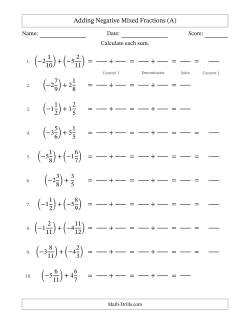
Although some of these worksheets are single operations, it should be helpful to have all of these in the same location. There are some special considerations when completing operations with negative fractions. It is usually very helpful to change any mixed numbers to an improper fraction before proceeding. It is important to pay attention to the signs and know the rules for multiplying positives and negatives (++ = +, +- = -, -+ = - and -- = +).
- Adding with Negative Fractions Adding Negative Proper Fractions with Unlike Denominators Up to Sixths, Proper Fractions Results and Some Simplifying (Fillable, Savable, Printable) ✎ Adding Negative Proper Fractions with Unlike Denominators Up to Twelfths, Proper Fractions Results and Some Simplifying (Fillable, Savable, Printable) ✎ Adding Negative Mixed Fractions with Unlike Denominators Up to Sixths, Proper Fractions Results and No Simplifying (Fillable, Savable, Printable) ✎ Adding Negative Mixed Fractions with Unlike Denominators Up to Twelfths, Proper Fractions Results and No Simplifying (Fillable, Savable, Printable) ✎ Adding Negative Proper Fractions with Denominators Up to Sixths, Proper Fraction Results and Some Simplifying (Printable Only) Adding Negative Proper Fractions with Denominators Up to Twelfths, Proper Fraction Results and Some Simplifying (Printable Only) Adding Negative Mixed Fractions with Denominators Up to Sixths and Some Simplifying (Printable Only) Adding Negative Mixed Fractions with Denominators Up to Twelfths and Some Simplifying (Printable Only)
- Subtracting with Negative Fractions Subtracting Negative Proper Fractions with Unlike Denominators Up to Sixths, Proper Fractions Results and Some Simplifying (Fillable, Savable, Printable) ✎ Subtracting Negative Proper Fractions with Unlike Denominators Up to Twelfths, Proper Fractions Results and Some Simplifying (Fillable, Savable, Printable) ✎ Subtracting Negative Mixed Fractions with Unlike Denominators Up to Sixths, Mixed Fractions Results and No Simplifying (Fillable, Savable, Printable) ✎ Subtracting Negative Mixed Fractions with Unlike Denominators Up to Twelfths, Mixed Fractions Results and No Simplifying (Fillable, Savable, Printable) ✎ Subtracting Negative Proper Fractions with Denominators Up to Sixths, Proper Fraction Results and Some Simplifying (Printable Only) Subtracting Negative Proper Fractions with Denominators Up to Twelfths, Proper Fraction Results and Some Simplifying (Printable Only) Subtracting Negative Mixed Fractions with Denominators Up to Sixths and Some Simplifying (Printable Only) Subtracting Negative Mixed Fractions with Denominators Up to Twelfths and Some Simplifying (Printable Only)
- Multiplying with Negative Fractions Multiplying Negative Proper Fractions with Denominators Up to Sixths, Proper Fractions Results and Some Simplifying (Fillable, Savable, Printable) ✎ Multiplying Negative Proper Fractions with Denominators Up to Twelfths, Proper Fractions Results and Some Simplifying (Fillable, Savable, Printable) ✎ Multiplying Negative Mixed Fractions with Denominators Up to Sixths, Proper Fractions Results and Some Simplifying (Fillable, Savable, Printable) ✎ Multiplying Negative Mixed Fractions with Denominators Up to Twelfths, Proper Fractions Results and Some Simplifying (Fillable, Savable, Printable) ✎ Multiplying Negative Proper Fractions with Denominators Up to Sixths, Proper Fraction Results and Some Simplifying (Printable Only) Multiplying Negative Proper Fractions with Denominators Up to Twelfths, Proper Fraction Results and Some Simplifying (Printable Only) Multiplying Negative Mixed Fractions with Denominators Up to Sixths and Some Simplifying (Printable Only) Multiplying Negative Mixed Fractions with Denominators Up to Twelfths and Some Simplifying (Printable Only)
- Dividing with Negative Fractions Dividing Negative Proper Fractions with Denominators Up to Sixths, Mixed Fractions Results and Some Simplifying (Fillable, Savable, Printable) ✎ Dividing Negative Proper Fractions with Denominators Up to Twelfths, Mixed Fractions Results and Some Simplifying (Fillable, Savable, Printable) ✎ Dividing Negative Mixed Fractions with Denominators Up to Twelfths, Mixed Fractions Results and No Simplifying (Fillable, Savable, Printable) ✎ Dividing Negative Mixed Fractions with Denominators Up to Twelfths, Mixed Fractions Results and No Simplifying (Fillable, Savable, Printable) ✎ Dividing Negative Proper Fractions with Denominators Up to Sixths, Proper Fraction Results and Some Simplifying (Printable Only) Dividing Negative Proper Fractions with Denominators Up to Twelfths, Proper Fraction Results and Some Simplifying (Printable Only) Dividing Negative Mixed Fractions with Denominators Up to Sixths and Some Simplifying (Printable Only) Dividing Negative Mixed Fractions with Denominators Up to Twelfths and Some Simplifying (Printable Only)
Order of Operations with Fractions Worksheets
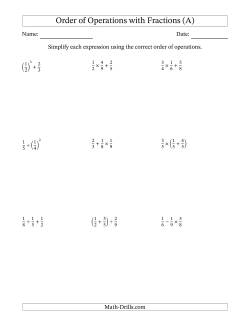
The order of operations worksheets in this section actually reside on the Order of Operations page, but they are included here for your convenience.
- Order of Operations with Fractions 2-Step Order of Operations with Fractions 3-Step Order of Operations with Fractions 4-Step Order of Operations with Fractions 5-Step Order of Operations with Fractions 6-Step Order of Operations with Fractions
- Order of Operations with Fractions (No Exponents) 2-Step Order of Operations with Fractions (No Exponents) 3-Step Order of Operations with Fractions (No Exponents) 4-Step Order of Operations with Fractions (No Exponents) 5-Step Order of Operations with Fractions (No Exponents) 6-Step Order of Operations with Fractions (No Exponents)
- Order of Operations with Positive and Negative Fractions 2-Step Order of Operations with Positive & Negative Fractions 3-Step Order of Operations with Positive & Negative Fractions 4-Step Order of Operations with Positive & Negative Fractions 5-Step Order of Operations with Positive & Negative Fractions 6-Step Order of Operations with Positive & Negative Fractions
Copyright © 2005-2024 Math-Drills.com You may use the math worksheets on this website according to our Terms of Use to help students learn math.

Or search by topic
Number and algebra
- The Number System and Place Value
- Calculations and Numerical Methods
- Fractions, Decimals, Percentages, Ratio and Proportion
- Properties of Numbers
- Patterns, Sequences and Structure
- Algebraic expressions, equations and formulae
- Coordinates, Functions and Graphs
Geometry and measure
- Angles, Polygons, and Geometrical Proof
- 3D Geometry, Shape and Space
- Measuring and calculating with units
- Transformations and constructions
- Pythagoras and Trigonometry
- Vectors and Matrices
Probability and statistics
- Handling, Processing and Representing Data
- Probability
Working mathematically
- Thinking mathematically
- Mathematical mindsets
- Cross-curricular contexts
- Physical and digital manipulatives
For younger learners
- Early Years Foundation Stage
Advanced mathematics
- Decision Mathematics and Combinatorics
- Advanced Probability and Statistics
Published 2013 Revised 2019
Exploring Fractions
- The first group gives you some starting points to explore with your class, which are applicable to a wide range of ages. The tasks in this first group will build on children's current understanding of fractions and will help them get to grips with the concept of the part-whole relationship.
- The second group of tasks focuses on the progression of ideas associated with fractions, through a problem-solving lens. So, the tasks in this second group are curriculum-linked but crucially also offer opportunities for learners to develop their problem-solving and reasoning skills.
- are applicable to a range of ages;
- provide contexts in which to explore the part-whole relationship in depth;
- offer opportunities to develop conceptual understanding through talk.

Game Central
Fraction Word Problems (Difficult)
Here are some examples of more difficult fraction word problems. We will illustrate how block models (tape diagrams) can be used to help you to visualize the fraction word problems in terms of the information given and the data that needs to be found.
Related Pages Fraction Word Problems Singapore Math Lessons Fraction Problems Using Algebra Algebra Word Problems
Block modeling (also known as tape diagrams or bar models) are widely used in Singapore Math and the Common Core to help students visualize and understand math word problems.
Example: 2/9 of the people on a restaurant are adults. If there are 95 more children than adults, how many children are there in the restaurant?
Solution: Draw a diagram with 9 equal parts: 2 parts to represent the adults and 7 parts to represent the children.
5 units = 95 1 unit = 95 ÷ 5 = 19 7 units = 7 × 19 = 133
Answer: There are 133 children in the restaurant.
Example: Gary and Henry brought an equal amount of money for shopping. Gary spent $95 and Henry spent $350. After that Henry had 4/7 of what Gary had left. How much money did Gary have left after shopping?
350 – 95 = 255 3 units = 255 1 unit = 255 ÷ 3 = 85 7 units = 85 × 7 = 595
Answer: Gary has $595 after shopping.
Example: 1/9 of the shirts sold at Peter’s shop are striped. 5/8 of the remainder are printed. The rest of the shirts are plain colored shirts. If Peter’s shop has 81 plain colored shirts, how many more printed shirts than plain colored shirts does the shop have?
Solution: Draw a diagram with 9 parts. One part represents striped shirts. Out of the remaining 8 parts: 5 parts represent the printed shirts and 3 parts represent plain colored shirts.
3 units = 81 1 unit = 81 ÷ 3 = 27 Printed shirts have 2 parts more than plain shirts. 2 units = 27 × 2 = 54
Answer: Peter’s shop has 54 more printed colored shirts than plain shirts.
Solve a problem involving fractions of fractions and fractions of remaining parts
Example: 1/4 of my trail mix recipe is raisins and the rest is nuts. 3/5 of the nuts are peanuts and the rest are almonds. What fraction of my trail mix is almonds?
How to solve fraction word problem that involves addition, subtraction and multiplication using a tape diagram or block model
Example: Jenny’s mom says she has an hour before it’s bedtime. Jenny spends 3/5 of the hour texting a friend and 3/8 of the remaining time brushing her teeth and putting on her pajamas. She spends the rest of the time reading her book. How long did Jenny read?
How to solve a four step fraction word problem using tape diagrams?
Example: In an auditorium, 1/6 of the students are fifth graders, 1/3 are fourth graders, and 1/4 of the remaining students are second graders. If there are 96 students in the auditorium, how many second graders are there?

We welcome your feedback, comments and questions about this site or page. Please submit your feedback or enquiries via our Feedback page.

10 Helpful Worksheet Ideas for Primary School Math Lessons
M athematics is a fundamental subject that shapes the way children think and analyze the world. At the primary school level, laying a strong foundation is crucial. While hands-on activities, digital tools, and interactive discussions play significant roles in learning, worksheets remain an essential tool for reinforcing concepts, practicing skills, and assessing understanding. Here’s a look at some helpful worksheets for primary school math lessons.
Comparison Chart Worksheets
Comparison charts provide a visual means for primary school students to grasp relationships between numbers or concepts. They are easy to make at www.storyboardthat.com/create/comparison-chart-template , and here is how they can be used:
- Quantity Comparison: Charts might display two sets, like apples vs. bananas, prompting students to determine which set is larger.
- Attribute Comparison: These compare attributes, such as different shapes detailing their number of sides and characteristics.
- Number Line Comparisons: These help students understand number magnitude by placing numbers on a line to visualize their relative sizes.
- Venn Diagrams: Introduced in later primary grades, these diagrams help students compare and contrast two sets of items or concepts.
- Weather Charts: By comparing weather on different days, students can learn about temperature fluctuations and patterns.
Number Recognition and Counting Worksheets
For young learners, recognizing numbers and counting is the first step into the world of mathematics. Worksheets can offer:
- Number Tracing: Allows students to familiarize themselves with how each number is formed.
- Count and Circle: Images are presented, and students have to count and circle the correct number.
- Missing Numbers: Sequences with missing numbers that students must fill in to practice counting forward and backward.
Basic Arithmetic Worksheets
Once students are familiar with numbers, they can start simple arithmetic.
- Addition and Subtraction within 10 or 20: Using visual aids like number lines, counters, or pictures can be beneficial.
- Word Problems: Simple real-life scenarios can help students relate math to their daily lives.
- Skip Counting: Worksheets focused on counting by 2s, 5s, or 10s.
Geometry and Shape Worksheets
Geometry offers a wonderful opportunity to relate math to the tangible world.
- Shape Identification: Recognizing and naming basic shapes such as squares, circles, triangles, etc.
- Comparing Shapes: Worksheets that help students identify differences and similarities between shapes.
- Pattern Recognition: Repeating shapes in patterns and asking students to determine the next shape in the sequence.
Measurement Worksheets
Measurement is another area where real-life application and math converge.
- Length and Height: Comparing two or more objects and determining which is longer or shorter.
- Weight: Lighter vs. heavier worksheets using balancing scales as visuals.
- Time: Reading clocks, days of the week, and understanding the calendar.
Data Handling Worksheets
Even at a primary level, students can start to understand basic data representation.
- Tally Marks: Using tally marks to represent data and counting them.
- Simple Bar Graphs: Interpreting and drawing bar graphs based on given data.
- Pictographs: Using pictures to represent data, which can be both fun and informative.
Place Value Worksheets
Understanding the value of each digit in a number is fundamental in primary math.
- Identifying Place Values: Recognizing units, tens, hundreds, etc., in a given number.
- Expanding Numbers: Breaking down numbers into their place value components, such as understanding 243 as 200 + 40 + 3.
- Comparing Numbers: Using greater than, less than, or equal to symbols to compare two numbers based on their place values.
Fraction Worksheets
Simple fraction concepts can be introduced at the primary level.
- Identifying Fractions: Recognizing half, quarter, third, etc., of shapes or sets.
- Comparing Fractions: Using visual aids like pie charts or shaded drawings to compare fractions.
- Simple Fraction Addition: Adding fractions with the same denominator using visual aids.
Money and Real-Life Application Worksheets
Understanding money is both practical and a great way to apply arithmetic.
- Identifying Coins and Notes: Recognizing different denominations.
- Simple Transactions: Calculating change, adding up costs, or determining if there’s enough money to buy certain items.
- Word Problems with Money: Real-life scenarios involving buying, selling, and saving.
Logic and Problem-Solving Worksheets
Even young students can hone their problem-solving skills with appropriate challenges.
- Sequences and Patterns: Predicting the next item in a sequence or recognizing a pattern.
- Logical Reasoning: Simple puzzles or riddles that require students to think critically.
- Story Problems: Reading a short story and solving a math-related problem based on the context.
Worksheets allow students to practice at their own pace, offer teachers a tool for assessment, and provide parents with a glimpse into their child’s learning progression. While digital tools and interactive activities are gaining prominence in education, the significance of worksheets remains undiminished. They are versatile and accessible and, when designed creatively, can make math engaging and fun for young learners.
The post 10 Helpful Worksheet Ideas for Primary School Math Lessons appeared first on Mom and More .
![Mathematics is a fundamental subject that shapes the way children think and analyze the world. At the primary school level, laying a strong foundation is crucial. While hands-on activities, digital tools, and interactive discussions play significant roles in learning, worksheets remain an essential tool for reinforcing concepts, practicing skills, and assessing understanding. Here’s a look […] Mathematics is a fundamental subject that shapes the way children think and analyze the world. At the primary school level, laying a strong foundation is crucial. While hands-on activities, digital tools, and interactive discussions play significant roles in learning, worksheets remain an essential tool for reinforcing concepts, practicing skills, and assessing understanding. Here’s a look […]](https://img-s-msn-com.akamaized.net/tenant/amp/entityid/AA1l9GSr.img?w=768&h=1152&m=6)

IMAGES
VIDEO
COMMENTS
Fraction word problems are math word problems involving fractions that require students to use problem-solving skills within the context of a real-world situation. To solve a fraction word problem, you must understand the context of the word problem, what the unknown information is, and what operation is needed to solve it.
Word problems with fractions: involving a fraction and a whole number. Finally, we are going to look at an example of a word problem with a fraction and a whole number. Now we will have to convert all the information into a fraction with the same denominator (as we did in the example above) in order to calculate. This morning Miguel bought 1 ...
Analysis: To solve this problem, we will add two mixed numbers, with the fractional parts having unlike denominators. Solution: Answer: The warehouse has 21 and one-half meters of tape in all. Example 8: An electrician has three and seven-sixteenths cm of wire. He needs only two and five-eighths cm of wire for a job.
Identify your areas for growth in these lessons: Dividing fractions by fractions. Dividing fractions word problems. Start quiz. Unit test. Test your understanding of Fractions with these NaN questions. Start test. In this topic, we will explore fractions conceptually and add, subtract, multiply, and divide fractions.
Math explained in easy language, plus puzzles, games, quizzes, videos and worksheets. For K-12 kids, teachers and parents. Fraction Worksheets ... Fractions - Subtraction. Worksheet. Example. Fractions (Same Denominator) 15 − 25. Unit Fractions. 13 − 19. Easy Proper Fractions. 38 − 27. Harder Proper Fractions. 712 − 1525.
Factor Fractions, examples with questions including solutions. Adding Fractions. Add fractions with same denominator or different denominator. Several examples with detailed solutions and exercises. Multiply Fractions. Multiply a fraction by another fraction or a number by a fraction. Examples with solutions and exercises.
Problem Solving using Fractions. Fractions are numbers that exist between whole numbers. We get fractions when we divide whole numbers into equal parts. Here we will learn to solve some real-life problems using fractions. ...Read More Read Less. Select your child's grade in school: Grade. 1. Grade. 2. Grade. 3. Grade. 4. Grade. 5.
To add fractions, they must have the same denominator. If they do, simply add the numerators together. [2] For instance, to solve 5/9 + 1/9, just add 5 + 1, which equals 6. The answer, then, is 6/9 which can be reduced to 2/3. 2. Subtract fractions with the same denominator by subtracting the numerators.
Fraction Word Problems - Examples and Worked Solutions of Word Problems, to solve a word problem that involves adding fractions with unlike denominators, Solve a problem involving fractions of fractions and fractions of remaining parts, using bar models or tape diagrams, with video lessons, examples and step-by-step solutions.
Multiply fractions word problems. Priya spent 1 1 2 days hiking. She was lost 5 6 of the time that she was hiking. What fraction of a day was Priya lost? days. Learn for free about math, art, computer programming, economics, physics, chemistry, biology, medicine, finance, history, and more. Khan Academy is a nonprofit with the mission of ...
Fraction Word Problems, The first example is a one-step word problem, The second example shows how blocks can be used to help illustrate the problem, The third example is a two-step word problem, bar modeling method in Singapore Math, Word Problem on Subtracting Fractions From Whole Numbers, with video lessons, examples and step-by-step solutions.
How to solve Fraction Word Problems using Algebra? Examples: (1) The denominator of a fraction is 5 more than the numerator. If 1 is subtracted from the numerator, the resulting fraction is 1/3. Find the original fraction. (2) If 3 is subtracted from the numerator of a fraction, the value of the resulting fraction is 1/2.
Unit 3 Intro to division. Understand fractions. Unit 5 Place value through 1,000,000. Unit 6 Add and subtract through 1,000,000. Unit 7 Multiply 1- and 2-digit numbers. Unit 8 Divide with remainders. Unit 9 Add and subtract fraction (like denominators) Unit 10 Multiply fractions. Unit 11 Decimals and place value.
Problem solving with fractions Problem solving is a fantastic way to put your knowledge into practise. Word problems can sometimes seem scary and more like a comprehension question in English.
Solving subtraction problems with fractions. Subtracting fractions is a lot like regular subtraction. If you can subtract whole numbers, you can subtract fractions too! Click through the slideshow to learn how to subtract fractions. Let's use our earlier example and subtract 1/4 of a tank of gas from 3/4 of a tank.
Presented here are the fraction pdf worksheets based on real-life scenarios. Read the basic fraction word problems, write the correct fraction and reduce your answer to the simplest form. Download the set. Represent and Simplify the Fractions: Type 2. Before representing in fraction, children should perform addition or subtraction to solve ...
Solution. Multiply both sides of the equation by the least common denominator for the fractions that appear in the equation. − 8 9x = 5 18 Original equation. 18( − 8 9x) = 18( 5 18) Multiply both sides by 18. − 16x = 5 On each side, cancel and multiply. 18( − 8 9) = − 16 and 18( 5 18) = 5.
Free Fractions calculator - Add, Subtract, Reduce, Divide and Multiply fractions step-by-step
Cut out the fraction circles and segments of one copy and leave the other copy intact. To add 1/3 + 1/2, for example, place a 1/3 segment and a 1/2 segment into a circle and hold it over various fractions on the intact copy to see what 1/2 + 1/3 is equivalent to. 5/6 or 10/12 should work. Small Fraction Circles.
Exploring Fractions. Introduction. At NRICH, our aim is to offer rich tasks which develop deep understanding of mathematical concepts. Of course, by their very nature, rich tasks will also provide opportunities for children to work like a mathematician and so help them develop their problem-solving skills alongside this conceptual understanding.
Quiz. 124 − 79. 124 ÷ 89. 124 + 89 × 315 − 1026. Learn about fractions using our free math solver with step-by-step solutions.
A fraction is the ratio of two numbers.Most commonly, we consider rational numbers, those fractions which are the ratio of two integers or decimals.. An example of a fraction is .In the example, the numerator is and represents the number of individual parts of a given fraction, and the denominator is and represents the individual parts needed for the fraction to be one whole.
Fraction Word Problems - using block models (tape diagrams), Solve a problem involving fractions of fractions and fractions of remaining parts, how to solve a four step fraction word problem using tape diagrams, grade 5, grade 6, grade 7, with video lessons, examples and step-by-step solutions.
Word Problems: Simple real-life scenarios can help students relate math to their daily lives. Skip Counting: Worksheets focused on counting by 2s, 5s, or 10s. Geometry and Shape Worksheets
Small live classes for advanced math and language arts learners in grades 2-12. Visit AoPS Academy ‚ Find a Physical Campus Visit the Virtual Campus